文章
Miss Chen
2022年07月04日

Creeping bellflower is a delicate, hardy, disease-resistant perennial that grows readily in a variety of conditions. Even though there are numerous bellflower species, the creeping variety is relatively easy to identify. The leaves found at the base of the plant are heart-shaped and become narrower and more lance-like as they move upwards. The drooping, bell-shaped purple flowers appear during the summer, growing up one side of the stem. You may think that a beautiful, easy-to-grow plant would make for a perfect garden bloom, but you'd be wrong—in fact, creeping bellflower is considered extremely invasive.
If you introduce this aggressive species to your garden, you must do so carefully and strategically—otherwise, it won't be long before it chokes out your other flowers and proves almost impossible to eradicate. It has a fast-spreading and deep root system of long tubers that can become many gardeners' nemesis if left untamed. Now that the extent of its aggressive nature has been discovered, it's classed as an invasive species across much of the country.
Brought to North America from its native Europe, creeping bellflower was initially a popular plant thanks to its ability to attract pollinators like bees and butterflies. Creeping bellflower produces an abundance of seeds in the summer (upwards of 15,000 per plant), which are then easily distributed by insects and gentle breezes. The plant will grow rapidly and can take over your landscape in as little as a season if left to its own devices. Ultimately, though it is beautiful, it's not recommended that you plant creeping bellflower in your garden or landscape.
Botanical Name Campanula rapunculoides
Common Name Creeping bellflower, rampion bellflower
Plant Type Herbaceous perennial
Mature Size 2–4 ft. tall, 1–3 ft. wide
Sun Exposure Full sun, partial shade
Soil Type Moist but well-drained
Soil pH Neutral to acidic
Bloom Time July to September
Flower Color Lavender, purple
Hardiness Zones 3–9 (USDA)
Native Area Europe
Creeping Bellflower Care
Creeping bellflower grows pretty much anywhere. It can thrive in various light conditions and handles a variety of different soil types easily—even those that have poor drainage or are infertile. It's found in most parts of North America, other than the hottest southeastern states. That being said, moist and shady locations are where the plant tends to be at its most invasive.
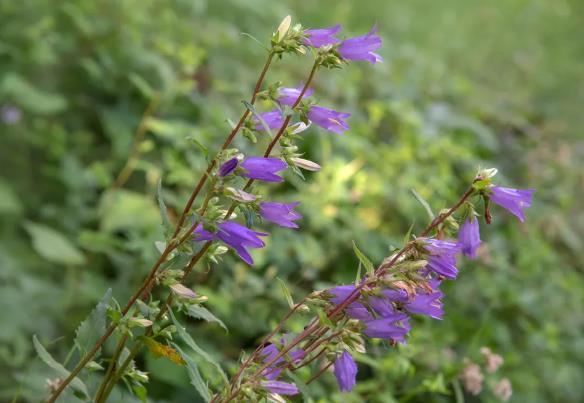
Light
Creeping bellflower will be most pervasive (and reseeds itself most aggressively) when growing in full sunlight. However, the plant can sustain just fine in partial shade and full shade locations as well.
Soil
While it can tolerate a variety of soil conditions, creeping bellflower will grow most prolifically in a soil blend that is moist but well-draining. Additionally, it can adapt to a wide range of neutral to acidic pH levels.
Water
Creeping bellflower plants prefer consistent water, and do best with about 1 inch of water per week, either from rainfall or manual watering methods. Once established, they are mildly drought-tolerant, though a lack of water will impact their blooming.
Temperature and Humidity
Though creeping bellflower is well-adapted to a variety of temperature and humidity environments, it spreads and grows most rapidly in the cooler weather of early spring or late fall. Additionally, the plants are cold-hardy down to about 5 degrees Fahrenheit, though they will cease to bloom at extremely cold temperatures.
Fertilizer
Creeping bellflower spreads readily and aggressively on its own, and should not be given fertilizer.
How to Remove Creeping Bellflower
Be prepared for a long project when attempting to eradicate the tenacious creeping bellflower from your landscape. Rigorous hand pulling, mowing, and deadheading won't eradicate the species, but it'll prevent reseeding and can help control spread somewhat. It can take several years of hard work to eliminate this species, and some horticulturists choose to focus on managing it instead.
Removing The Roots
Part of the problem with removing creeping bellflower is that its white, fleshy underground rhizomes and deep taproots can't simply be pulled out. Doing so carelessly will inevitably leave pieces still in the soil, and even the smallest rhizomatous section can result in regrowth.
For the best success, digging out the roots is required. You'll need to dig at least 6 to 9 inches into the soil on all sides of the plant. Slowly and methodically sift out any root sections you find, and all parts of the plant should be put into sealed general waste bags. If added to compost heaps or bins, they could grow back once the compost is applied.
Creeping bellflower roots can also become entangled with the roots of other nearby plants. You may have to sacrifice other species while you're working to rid your garden of this weed. If you have a prized plant you want to try saving, it's best to remove it and carefully try to separate it from the roots of the bellflower. The roots should then be washed off, and the plant should be kept in a pot to make sure that no creeping bellflower growth reappears.
Smothering Methods
Another method for removing creeping bellflower is to cover the plants to deprive them of light. However, this is only practical if the flowers are growing in small patches. To do so, you can use newspapers, cardboard, or plastic, which is then covered over with soil or heavy mulch. Though it may seem easier, this method isn't always foolproof—sometimes, creeping bellflower's roots will lie in a dormant state (tricking you into thinking it's been eradicated) and new growth could appear the following season.

Chemical Removal
Chemically removing your creeping bellflower is best kept as a last resort. Not only can herbicides pose a risk to the environment, humans, and animals alike, but they don't always have the best success rate. However, if you find the plant has invaded your patio. driveway cracks, or paved areas in your garden, it could be worth adopting this method as it won't be possible to dig up the roots. Likewise, if the plants have spread to your lawn, you could apply a herbicide containing the active ingredient triclopyr as this won't damage the grass.
Widely available broadleaf herbicides and defoliants such as 2,4-D have been proven ineffective at dealing with creeping bellflower. Limited success has been shown, however, with those that contain the active ingredient glyphosate, likeRoundup. Applying the treatment directly with a sponge can prevent it from coming into contact with other nearby broadleaf species. Best success, however, will occur if it's sprayed generously on the plant.
Treatments should be applied in late spring or early fall, while temperatures are between 60 degrees Fahrenheit and 85 degrees Fahrenheit. You also want to ensure there isn't any rain in the forecast for at least a couple of days after the treatment, too. Weekly reapplications for several weeks are often recommended.
If you introduce this aggressive species to your garden, you must do so carefully and strategically—otherwise, it won't be long before it chokes out your other flowers and proves almost impossible to eradicate. It has a fast-spreading and deep root system of long tubers that can become many gardeners' nemesis if left untamed. Now that the extent of its aggressive nature has been discovered, it's classed as an invasive species across much of the country.
Brought to North America from its native Europe, creeping bellflower was initially a popular plant thanks to its ability to attract pollinators like bees and butterflies. Creeping bellflower produces an abundance of seeds in the summer (upwards of 15,000 per plant), which are then easily distributed by insects and gentle breezes. The plant will grow rapidly and can take over your landscape in as little as a season if left to its own devices. Ultimately, though it is beautiful, it's not recommended that you plant creeping bellflower in your garden or landscape.
Botanical Name Campanula rapunculoides
Common Name Creeping bellflower, rampion bellflower
Plant Type Herbaceous perennial
Mature Size 2–4 ft. tall, 1–3 ft. wide
Sun Exposure Full sun, partial shade
Soil Type Moist but well-drained
Soil pH Neutral to acidic
Bloom Time July to September
Flower Color Lavender, purple
Hardiness Zones 3–9 (USDA)
Native Area Europe
Creeping Bellflower Care
Creeping bellflower grows pretty much anywhere. It can thrive in various light conditions and handles a variety of different soil types easily—even those that have poor drainage or are infertile. It's found in most parts of North America, other than the hottest southeastern states. That being said, moist and shady locations are where the plant tends to be at its most invasive.

Light
Creeping bellflower will be most pervasive (and reseeds itself most aggressively) when growing in full sunlight. However, the plant can sustain just fine in partial shade and full shade locations as well.
Soil
While it can tolerate a variety of soil conditions, creeping bellflower will grow most prolifically in a soil blend that is moist but well-draining. Additionally, it can adapt to a wide range of neutral to acidic pH levels.
Water
Creeping bellflower plants prefer consistent water, and do best with about 1 inch of water per week, either from rainfall or manual watering methods. Once established, they are mildly drought-tolerant, though a lack of water will impact their blooming.
Temperature and Humidity
Though creeping bellflower is well-adapted to a variety of temperature and humidity environments, it spreads and grows most rapidly in the cooler weather of early spring or late fall. Additionally, the plants are cold-hardy down to about 5 degrees Fahrenheit, though they will cease to bloom at extremely cold temperatures.
Fertilizer
Creeping bellflower spreads readily and aggressively on its own, and should not be given fertilizer.
How to Remove Creeping Bellflower
Be prepared for a long project when attempting to eradicate the tenacious creeping bellflower from your landscape. Rigorous hand pulling, mowing, and deadheading won't eradicate the species, but it'll prevent reseeding and can help control spread somewhat. It can take several years of hard work to eliminate this species, and some horticulturists choose to focus on managing it instead.
Removing The Roots
Part of the problem with removing creeping bellflower is that its white, fleshy underground rhizomes and deep taproots can't simply be pulled out. Doing so carelessly will inevitably leave pieces still in the soil, and even the smallest rhizomatous section can result in regrowth.
For the best success, digging out the roots is required. You'll need to dig at least 6 to 9 inches into the soil on all sides of the plant. Slowly and methodically sift out any root sections you find, and all parts of the plant should be put into sealed general waste bags. If added to compost heaps or bins, they could grow back once the compost is applied.
Creeping bellflower roots can also become entangled with the roots of other nearby plants. You may have to sacrifice other species while you're working to rid your garden of this weed. If you have a prized plant you want to try saving, it's best to remove it and carefully try to separate it from the roots of the bellflower. The roots should then be washed off, and the plant should be kept in a pot to make sure that no creeping bellflower growth reappears.
Smothering Methods
Another method for removing creeping bellflower is to cover the plants to deprive them of light. However, this is only practical if the flowers are growing in small patches. To do so, you can use newspapers, cardboard, or plastic, which is then covered over with soil or heavy mulch. Though it may seem easier, this method isn't always foolproof—sometimes, creeping bellflower's roots will lie in a dormant state (tricking you into thinking it's been eradicated) and new growth could appear the following season.

Chemical Removal
Chemically removing your creeping bellflower is best kept as a last resort. Not only can herbicides pose a risk to the environment, humans, and animals alike, but they don't always have the best success rate. However, if you find the plant has invaded your patio. driveway cracks, or paved areas in your garden, it could be worth adopting this method as it won't be possible to dig up the roots. Likewise, if the plants have spread to your lawn, you could apply a herbicide containing the active ingredient triclopyr as this won't damage the grass.
Widely available broadleaf herbicides and defoliants such as 2,4-D have been proven ineffective at dealing with creeping bellflower. Limited success has been shown, however, with those that contain the active ingredient glyphosate, likeRoundup. Applying the treatment directly with a sponge can prevent it from coming into contact with other nearby broadleaf species. Best success, however, will occur if it's sprayed generously on the plant.
Treatments should be applied in late spring or early fall, while temperatures are between 60 degrees Fahrenheit and 85 degrees Fahrenheit. You also want to ensure there isn't any rain in the forecast for at least a couple of days after the treatment, too. Weekly reapplications for several weeks are often recommended.
0
0
文章
Miss Chen
2022年02月21日

The cast-iron plant (Aspidistra elatior) has earned its reputation as a hard-to-kill houseplant, along with being a beautiful outdoor foliage plant within its growing zones. This plant can survive lots of neglect and growing conditions that will kill many other plants, such as low light conditions. It has arching, lance-shaped, deep green, glossy leaves that can reach around 2 feet long and 4 inches wide. When grown outdoors, it sometimes produces insignificant cream and purple flowers near the base of the plant, but the blossoms usually do not appear when the plant is grown indoors. The cast-iron plant has a fairly slow growth rate, and spring is generally the best time to plant it.
Common Name Cast-iron plant, bar room plant
Botanical Name Aspidistra elatior
Family Asparagaceae
Plant Type Perennial, herbaceous
Mature Size 2–3 ft. tall, 1–2 ft. wide
Sun Exposure Partial, shade
Soil Type Well-drained
Soil pH Acidic, neutral
Bloom Time Spring, summer
Flower Color White/purple
Hardiness Zones 8–10, USA
Native Area Asia
Cast-Iron Plant Care
For a gardener with a brown thumb, this sturdy, long-lasting plant can be used in areas where all else fails. It is always green and can handle deep shade under deck stairs or along foundations that receive almost no sunlight. Plus, insects usually leave it alone, and it very rarely is bothered by disease.
Cast-iron plants require very simple maintenance: watering when the soil dries out and fertilizing for part of the year. Most mistakes that occur with these plants involve overwatering (they dislike waterlogged soil) or placing them in direct sunlight. With cast-iron plants, a fairly hands-off approach is typically best.
Light
Keep cast-iron plants away from direct sunlight, which can bleach and burn the leaves. If you're keeping one as a houseplant, a north-facing window is ideal. Set it slightly back from windows that get strong light to avoid direct sun. When growing cast-iron plants outdoors, place them in a shady area with indirect sunlight.
Soil
Cast-iron plants tolerate a wide range of soils, as long as they have good drainage. They prefer organically rich soil with a slightly acidic to neutral soil pH. Outdoors, they can grow in sandy, loamy, and even clay soils. For container plants, simply use a standard quality potting mix.
Water
While these plants have some drought tolerance, they like a moderate amount of soil moisture. Water young cast-iron plants regularly to keep the soil lightly moist but not soggy. Soil that remains wet for too long can cause root rot. Water established plants deeply, and then let the soil dry out a few inches down before watering again. A good general rule is to water when you can stick your finger in the soil and not feel any dampness.
Temperature and Humidity
Cast-iron plants prefer temperatures between 60 and 75 degrees Fahrenheit. They are not hardy to cold, and temperatures that drop below 50 degrees Fahrenheit can damage or kill them. So if you're growing your plant in a container outdoors, be sure to take it inside well before the threat of frost. Moreover, cast-iron plants like a moderate humidity level, but it's not a necessity for healthy growth.
Fertilizer
Feed your cast-iron plant once a month with an all-purpose liquid fertilizer during the spring and summer months, following label instructions, or use a slow-release fertilizer in the spring. It's not necessary to fertilize during the fall and winter months. Only apply fertilizer after watering the plant to avoid burning the roots.
Types of Cast-Iron Plants
There are several varieties of cast-iron plants, including:
'Variegata': This cultivar features green leaves with white stripes.
'Asahi': This variety's green leaves develop white tips as they grow.
'Hoshi-zora': This plant's name translates to starry sky, and its green leaves are speckled with yellow to white dots.
'Lennon's Song': The leaves on this variety have light green or yellow stripes.
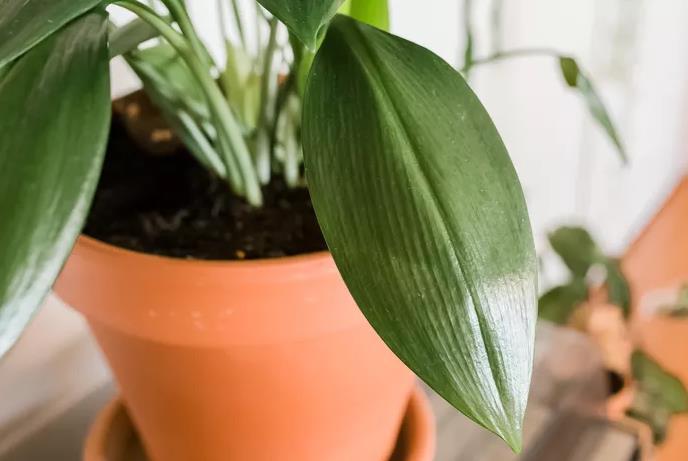
Propagating Cast-Iron Plants
Cast-iron plants can be propagated by division. Not only does this give you a new plant for less than it would cost at a nursery, but division also prevents mature plants from becoming overcrowded.
To start a new plant, take a piece of the rhizome (underground stem) that includes at least two leaves. Plant this piece either in a pot with fresh potting mix or directly in the ground. Keep the soil lightly moist, but ensure that it has good drainage. Also, make sure the new plant stays warm but isn't in direct sunlight. Once you see new shoots develop, you'll know your new cast-iron plant has developed its root system and its hardiness. Then, you can begin to treat it like an established plant.
Potting and Repotting Cast-Iron Plants
When growing cast-iron plants in containers, it's key to use a pot with ample drainage holes. An unglazed clay container also is ideal because it will allow excess soil moisture to escape through its walls. Select a pot that's just slightly larger than the root ball to start, as these slow-growing plants won't outgrow their containers quickly.
Once you see roots growing out of the soil, you'll know it's time to repot your cast-iron plant into something slightly larger. This might not happen for three to five years. Ideally, try to repot in the springtime, and select one container size up. Gently remove your plant from its old pot, and place it at the same depth in the new pot with fresh potting mix.
Common Pests
Cast-iron plants do not often succumb to pest or disease problems, especially when grown in their natural environment. As houseplants, they can be slightly susceptible to common houseplant pests, including mites and scale. Rinsing the foliage can help to dislodge the pests and control a minor infestation. For more severe infestations, consider an insecticidal soap or horticultural oil.
Common Problems With Cast-Iron Plants
Cast-iron plants have very few problems as long as they're grown in their preferred conditions. But some common issues can arise when the environment isn't to their liking.
Browning Tips
Brown leaf tips are commonly due to overwatering or underwatering, especially with cast-iron plants grown in containers. Always check the soil moisture before watering, and wait to water until the soil is dry a few inches down. Also, ensure that excess water is able to drain out of the container.

Leaves Turning Brown
Parts of or even entire leaves turning brown on cast-iron plants is often the result of too much sunlight. Check your plant throughout the day to make sure direct sun is never hitting it, and relocate it if necessary. Drafts indoors, especially from air-conditioning vents, and cold temperatures outdoors also can cause browning foliage. Make sure your plant is protected from temperature extremes.
FAQ
Do cast-iron plants need sun?
Cast-iron plants must stay out of direct sunlight, but they do need some indirect sun to grow.
Are cast-iron plants easy to care for?
Cast-iron plants are extremely hardy and require little maintenance to keep them looking their best.
How fast do cast-iron plants grow?
The cast-iron plant grows slowly and can take several years to reach its mature size.
Common Name Cast-iron plant, bar room plant
Botanical Name Aspidistra elatior
Family Asparagaceae
Plant Type Perennial, herbaceous
Mature Size 2–3 ft. tall, 1–2 ft. wide
Sun Exposure Partial, shade
Soil Type Well-drained
Soil pH Acidic, neutral
Bloom Time Spring, summer
Flower Color White/purple
Hardiness Zones 8–10, USA
Native Area Asia
Cast-Iron Plant Care
For a gardener with a brown thumb, this sturdy, long-lasting plant can be used in areas where all else fails. It is always green and can handle deep shade under deck stairs or along foundations that receive almost no sunlight. Plus, insects usually leave it alone, and it very rarely is bothered by disease.
Cast-iron plants require very simple maintenance: watering when the soil dries out and fertilizing for part of the year. Most mistakes that occur with these plants involve overwatering (they dislike waterlogged soil) or placing them in direct sunlight. With cast-iron plants, a fairly hands-off approach is typically best.
Light
Keep cast-iron plants away from direct sunlight, which can bleach and burn the leaves. If you're keeping one as a houseplant, a north-facing window is ideal. Set it slightly back from windows that get strong light to avoid direct sun. When growing cast-iron plants outdoors, place them in a shady area with indirect sunlight.
Soil
Cast-iron plants tolerate a wide range of soils, as long as they have good drainage. They prefer organically rich soil with a slightly acidic to neutral soil pH. Outdoors, they can grow in sandy, loamy, and even clay soils. For container plants, simply use a standard quality potting mix.
Water
While these plants have some drought tolerance, they like a moderate amount of soil moisture. Water young cast-iron plants regularly to keep the soil lightly moist but not soggy. Soil that remains wet for too long can cause root rot. Water established plants deeply, and then let the soil dry out a few inches down before watering again. A good general rule is to water when you can stick your finger in the soil and not feel any dampness.
Temperature and Humidity
Cast-iron plants prefer temperatures between 60 and 75 degrees Fahrenheit. They are not hardy to cold, and temperatures that drop below 50 degrees Fahrenheit can damage or kill them. So if you're growing your plant in a container outdoors, be sure to take it inside well before the threat of frost. Moreover, cast-iron plants like a moderate humidity level, but it's not a necessity for healthy growth.
Fertilizer
Feed your cast-iron plant once a month with an all-purpose liquid fertilizer during the spring and summer months, following label instructions, or use a slow-release fertilizer in the spring. It's not necessary to fertilize during the fall and winter months. Only apply fertilizer after watering the plant to avoid burning the roots.
Types of Cast-Iron Plants
There are several varieties of cast-iron plants, including:
'Variegata': This cultivar features green leaves with white stripes.
'Asahi': This variety's green leaves develop white tips as they grow.
'Hoshi-zora': This plant's name translates to starry sky, and its green leaves are speckled with yellow to white dots.
'Lennon's Song': The leaves on this variety have light green or yellow stripes.

Propagating Cast-Iron Plants
Cast-iron plants can be propagated by division. Not only does this give you a new plant for less than it would cost at a nursery, but division also prevents mature plants from becoming overcrowded.
To start a new plant, take a piece of the rhizome (underground stem) that includes at least two leaves. Plant this piece either in a pot with fresh potting mix or directly in the ground. Keep the soil lightly moist, but ensure that it has good drainage. Also, make sure the new plant stays warm but isn't in direct sunlight. Once you see new shoots develop, you'll know your new cast-iron plant has developed its root system and its hardiness. Then, you can begin to treat it like an established plant.
Potting and Repotting Cast-Iron Plants
When growing cast-iron plants in containers, it's key to use a pot with ample drainage holes. An unglazed clay container also is ideal because it will allow excess soil moisture to escape through its walls. Select a pot that's just slightly larger than the root ball to start, as these slow-growing plants won't outgrow their containers quickly.
Once you see roots growing out of the soil, you'll know it's time to repot your cast-iron plant into something slightly larger. This might not happen for three to five years. Ideally, try to repot in the springtime, and select one container size up. Gently remove your plant from its old pot, and place it at the same depth in the new pot with fresh potting mix.
Common Pests
Cast-iron plants do not often succumb to pest or disease problems, especially when grown in their natural environment. As houseplants, they can be slightly susceptible to common houseplant pests, including mites and scale. Rinsing the foliage can help to dislodge the pests and control a minor infestation. For more severe infestations, consider an insecticidal soap or horticultural oil.
Common Problems With Cast-Iron Plants
Cast-iron plants have very few problems as long as they're grown in their preferred conditions. But some common issues can arise when the environment isn't to their liking.
Browning Tips
Brown leaf tips are commonly due to overwatering or underwatering, especially with cast-iron plants grown in containers. Always check the soil moisture before watering, and wait to water until the soil is dry a few inches down. Also, ensure that excess water is able to drain out of the container.

Leaves Turning Brown
Parts of or even entire leaves turning brown on cast-iron plants is often the result of too much sunlight. Check your plant throughout the day to make sure direct sun is never hitting it, and relocate it if necessary. Drafts indoors, especially from air-conditioning vents, and cold temperatures outdoors also can cause browning foliage. Make sure your plant is protected from temperature extremes.
FAQ
Do cast-iron plants need sun?
Cast-iron plants must stay out of direct sunlight, but they do need some indirect sun to grow.
Are cast-iron plants easy to care for?
Cast-iron plants are extremely hardy and require little maintenance to keep them looking their best.
How fast do cast-iron plants grow?
The cast-iron plant grows slowly and can take several years to reach its mature size.
0
0
文章
Miss Chen
2021年11月28日

The showy bromeliad may look difficult to grow but it can easily adapt to average home conditions with its astonishing array of colors and textures. Although many do have very splashy flower displays, bromeliads are just as popular as beautiful foliage plants with leaves in red, green, purple, orange, and yellow colors and with bands, stripes, spots, and other features. Bromeliads are relatively slow-growing plants that take one to three years to mature into flowering plants.
Common Name Bromeliad
Botanical Name Bromeliaceae genera
Family Bromeliaceae
Plant Type Perennials; family includes both epiphyte ("air plant") and terrestrial species
Mature Size Varies by genera and species
Sun Exposure Bright, indirect light
Soil Type Fast-draining potting soil
Soil pH 5.0 to 6.0 (acidic)
Bloom Time Blooms once; timing varies
Flower Color Red, green, purple, orange, yellow
Hardiness Zones 10-11 (USDA); usually grown as houseplants
Native Area Tropical and subtropical Americas

Bromeliad Care
In general, bromeliads need a fairly specific set of conditions to bloom—and these conditions vary from genus to genus, and even from species to species in a single genus. Their bloom cycle is affected by day length, temperature, humidity, water, and feeding. You will need to research specific genera and species to determine how best to grow them.
Bromeliad species can either be terrestrial (grown in soil) or epiphytic (clinging to trees and absorbing nutrients through their leaves), but when grown as houseplants, both types are usually grown in a porous, well-draining potting mixture. As a general rule of thumb, bromeliads will thrive in the same conditions as epiphytic orchids. However, they are considerably more tolerant than orchids of fluctuations in temperature, drought, and careless feeding.
When cultivated as indoor plants, most bromeliads—both epiphytic and terrestrial species—are usually planted in a mixture of potting soil and sand. Watering is done either by moistening the soil or by filling the center depression ("cup") formed by the rosette of leaves.
Light
Different genera of bromeliads are tolerant of different levels of light. Some can withstand full tropical sun, while others will quickly scorch. In general, the varieties with soft, flexible, spineless leaves usually prefer lower light levels, while those with stiff, hard leaves prefer bright indirect light.
Plants that are yellowish might be receiving too much light, while plants that are dark green or elongated might be receiving too little light. Increasing light exposure can help the plant bloom, provided the other conditions are appropriate.1
Soil
Bromeliads grown indoors thrive in fast-draining potting soil that holds moisture but drains well. A mixture of two-thirds peat-based soil and one-third sand is often ideal. You can also use orchid mix, charcoal, or soilless potting mix. Many bromeliads that are epiphytic can be grown in containers, or you can try to grow them as authentic "air plants" mounted to boards or logs (typically secured with ties or glue).
Water
Bromeliads are very tolerant of drought conditions. In a typical house, it's usually not necessary to keep the central cup of the plant constantly filled with water. But this is an option if the light levels and temperature are high. If you do centrally water your bromeliad, make sure to flush the central cup every so often to remove any built-up salts. But in general, it's enough to water these plants very sparingly through the soil weekly during the growing season and reduce watering during the winter rest period. Never let the plant rest in standing water.1
Plants you are growing as epiphytes (as air plants without soil) need more consistent watering; drench them once a day, and give them a good soaking by submerging them in water once per week.
Temperature and Humidity
Bromeliads are also highly tolerant of temperature variations, but plants in hotter conditions need more humidity. Bromeliads prefer temperatures between 55 and 80 degrees Fahrenheit. Though some cold-hardy types can survive temperatures down to 20 degrees, they should generally not be exposed to temperatures under 40 degrees.1 They grow well indoors at humidity levels between 40 percent and 60 percent. In many climates, bromeliads can be moved outdoors during the summer.
Fertilizer
Bromeliads are not heavy feeders. During the growing season, use a liquid fertilizer diluted at one-eighth or one-quarter strength, applied every two to four weeks. If you use a slow-release pellet fertilizer, apply a single pellet once each season when watering the central cup. Avoid feeding mature plants in winter or when the plant begins to flower.
Types of Bromeliads
Although houseplant bromeliads are usually grown in a blended potting mix, many species are epiphytic plants when found in their native range—the tropical and subtropical regions of the Americas. Some common genera of bromeliads used as houseplants include:
Guzmania: This genus includes most of the most common and readily available species, including G. lingulata, G. zahnii , G. Guzmania sanguinea, and G. monostachia. These plants have long, flat glossy green leaves. The most common varieties have bracts that are bright red (one common name for this plant is scarlet star), but depending on species, there are some that are yellow, orange, purple, or pink. The blooms are very long-lasting, holding up for two to four months.
Neoregelia: This is the most diverse of all the bromeliad genera. Those species used as houseplants have some of the most colorful bracts, ranging from pink to deep purple. These plants form short, fairly flat rosettes of leaves; some miniatures are no more than 1 inch across while other plants can be as much as 40 inches wide.
Vriesea: The species in the Vriesea genus features tropical, feather-like blooms and variegated foliage. Among the popular varieties are V. splendens and the hybrid Vreisea' Fireworks'.
Ananas comosus 'Champaca':Ananas is the genus that includes the common pineapple, and the cultivar of one species, A. Comosus 'Champaca', is an ornamental pineapple often grown as a houseplant. This bromeliad features spidery leaves and miniature pineapples on top of the flower spike.
Propagating Bromeliads
Propagating bromeliads from shoots is preferred over the less common and difficult way of growing the plant from seeds. Bromeliads multiply by sending up offsets, or pups. In a natural growth cycle, a mature plant will send up a flower spike that includes small, sometimes insignificant flowers surrounded by showy bracts. (It's really the bracts that are most appealing in these plants). The flower bracts are often long-lasting—sometimes for months.
After the flower dies, the plant also begins to die over the next few months. However, the parent plant will send out one or several smaller pups at its base. These pups can be carefully cut off with sterile scissors and potted individually in their own containers. Pups should only be potted after they develop a few roots and begin to form the central cup that's characteristic of bromeliads.
Common Pests
Although sometimes susceptible to mealybugs, aphids, and scale, bromeliads are largely free of severe pests.1 You can eliminate mealybugs and aphids by spraying the plant with a mixture of water and a few drops of dish soap. Dab scale bugs with a cotton swab doused with rubbing alcohol.
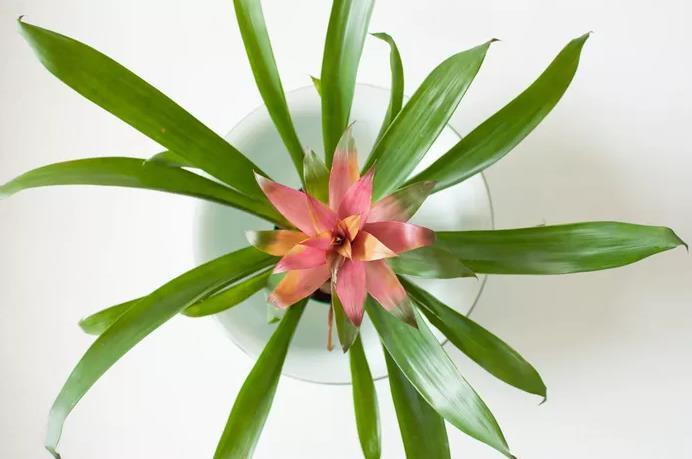
How to Get Bromeliads to Bloom
While it can be difficult to accurately replicate the conditions any particular bromeliad needs to bloom, some research has shown the plants can be forced to bloom by exposure to ethylene gas.2 So if you want to force your plant to spike, place it in a tightly sealed, clear plastic bag for up to 10 days with a ripe apple. The apple will give off ethylene gas as it decomposes. Make sure any water is drained from the bromeliad's central cup before attempting this.
Common Problems With Bromeliads
Though bromeliads are somewhat easy-going plants, they can be prone to some cultural issues. Stay aware of the following problems:
Overwatering
When you're watering, if you're over-saturating the potting soil rather than filling the central "cup" formed by the leaves, bromeliads can develop rot. These are plants that prefer relatively dry conditions.3
Hard Water
Water high in mineral content can cause water spots on the base of the plant and in the center cup. It is best to water with demineralized water.4
Improper Container
Bromeliads don't have a large root system, so plant them in small, well-draining pots that won't collect a lot of water. Planting them in a too large pot without drainage can lead to rot.
Common Name Bromeliad
Botanical Name Bromeliaceae genera
Family Bromeliaceae
Plant Type Perennials; family includes both epiphyte ("air plant") and terrestrial species
Mature Size Varies by genera and species
Sun Exposure Bright, indirect light
Soil Type Fast-draining potting soil
Soil pH 5.0 to 6.0 (acidic)
Bloom Time Blooms once; timing varies
Flower Color Red, green, purple, orange, yellow
Hardiness Zones 10-11 (USDA); usually grown as houseplants
Native Area Tropical and subtropical Americas

Bromeliad Care
In general, bromeliads need a fairly specific set of conditions to bloom—and these conditions vary from genus to genus, and even from species to species in a single genus. Their bloom cycle is affected by day length, temperature, humidity, water, and feeding. You will need to research specific genera and species to determine how best to grow them.
Bromeliad species can either be terrestrial (grown in soil) or epiphytic (clinging to trees and absorbing nutrients through their leaves), but when grown as houseplants, both types are usually grown in a porous, well-draining potting mixture. As a general rule of thumb, bromeliads will thrive in the same conditions as epiphytic orchids. However, they are considerably more tolerant than orchids of fluctuations in temperature, drought, and careless feeding.
When cultivated as indoor plants, most bromeliads—both epiphytic and terrestrial species—are usually planted in a mixture of potting soil and sand. Watering is done either by moistening the soil or by filling the center depression ("cup") formed by the rosette of leaves.
Light
Different genera of bromeliads are tolerant of different levels of light. Some can withstand full tropical sun, while others will quickly scorch. In general, the varieties with soft, flexible, spineless leaves usually prefer lower light levels, while those with stiff, hard leaves prefer bright indirect light.
Plants that are yellowish might be receiving too much light, while plants that are dark green or elongated might be receiving too little light. Increasing light exposure can help the plant bloom, provided the other conditions are appropriate.1
Soil
Bromeliads grown indoors thrive in fast-draining potting soil that holds moisture but drains well. A mixture of two-thirds peat-based soil and one-third sand is often ideal. You can also use orchid mix, charcoal, or soilless potting mix. Many bromeliads that are epiphytic can be grown in containers, or you can try to grow them as authentic "air plants" mounted to boards or logs (typically secured with ties or glue).
Water
Bromeliads are very tolerant of drought conditions. In a typical house, it's usually not necessary to keep the central cup of the plant constantly filled with water. But this is an option if the light levels and temperature are high. If you do centrally water your bromeliad, make sure to flush the central cup every so often to remove any built-up salts. But in general, it's enough to water these plants very sparingly through the soil weekly during the growing season and reduce watering during the winter rest period. Never let the plant rest in standing water.1
Plants you are growing as epiphytes (as air plants without soil) need more consistent watering; drench them once a day, and give them a good soaking by submerging them in water once per week.
Temperature and Humidity
Bromeliads are also highly tolerant of temperature variations, but plants in hotter conditions need more humidity. Bromeliads prefer temperatures between 55 and 80 degrees Fahrenheit. Though some cold-hardy types can survive temperatures down to 20 degrees, they should generally not be exposed to temperatures under 40 degrees.1 They grow well indoors at humidity levels between 40 percent and 60 percent. In many climates, bromeliads can be moved outdoors during the summer.
Fertilizer
Bromeliads are not heavy feeders. During the growing season, use a liquid fertilizer diluted at one-eighth or one-quarter strength, applied every two to four weeks. If you use a slow-release pellet fertilizer, apply a single pellet once each season when watering the central cup. Avoid feeding mature plants in winter or when the plant begins to flower.
Types of Bromeliads
Although houseplant bromeliads are usually grown in a blended potting mix, many species are epiphytic plants when found in their native range—the tropical and subtropical regions of the Americas. Some common genera of bromeliads used as houseplants include:
Guzmania: This genus includes most of the most common and readily available species, including G. lingulata, G. zahnii , G. Guzmania sanguinea, and G. monostachia. These plants have long, flat glossy green leaves. The most common varieties have bracts that are bright red (one common name for this plant is scarlet star), but depending on species, there are some that are yellow, orange, purple, or pink. The blooms are very long-lasting, holding up for two to four months.
Neoregelia: This is the most diverse of all the bromeliad genera. Those species used as houseplants have some of the most colorful bracts, ranging from pink to deep purple. These plants form short, fairly flat rosettes of leaves; some miniatures are no more than 1 inch across while other plants can be as much as 40 inches wide.
Vriesea: The species in the Vriesea genus features tropical, feather-like blooms and variegated foliage. Among the popular varieties are V. splendens and the hybrid Vreisea' Fireworks'.
Ananas comosus 'Champaca':Ananas is the genus that includes the common pineapple, and the cultivar of one species, A. Comosus 'Champaca', is an ornamental pineapple often grown as a houseplant. This bromeliad features spidery leaves and miniature pineapples on top of the flower spike.
Propagating Bromeliads
Propagating bromeliads from shoots is preferred over the less common and difficult way of growing the plant from seeds. Bromeliads multiply by sending up offsets, or pups. In a natural growth cycle, a mature plant will send up a flower spike that includes small, sometimes insignificant flowers surrounded by showy bracts. (It's really the bracts that are most appealing in these plants). The flower bracts are often long-lasting—sometimes for months.
After the flower dies, the plant also begins to die over the next few months. However, the parent plant will send out one or several smaller pups at its base. These pups can be carefully cut off with sterile scissors and potted individually in their own containers. Pups should only be potted after they develop a few roots and begin to form the central cup that's characteristic of bromeliads.
Common Pests
Although sometimes susceptible to mealybugs, aphids, and scale, bromeliads are largely free of severe pests.1 You can eliminate mealybugs and aphids by spraying the plant with a mixture of water and a few drops of dish soap. Dab scale bugs with a cotton swab doused with rubbing alcohol.

How to Get Bromeliads to Bloom
While it can be difficult to accurately replicate the conditions any particular bromeliad needs to bloom, some research has shown the plants can be forced to bloom by exposure to ethylene gas.2 So if you want to force your plant to spike, place it in a tightly sealed, clear plastic bag for up to 10 days with a ripe apple. The apple will give off ethylene gas as it decomposes. Make sure any water is drained from the bromeliad's central cup before attempting this.
Common Problems With Bromeliads
Though bromeliads are somewhat easy-going plants, they can be prone to some cultural issues. Stay aware of the following problems:
Overwatering
When you're watering, if you're over-saturating the potting soil rather than filling the central "cup" formed by the leaves, bromeliads can develop rot. These are plants that prefer relatively dry conditions.3
Hard Water
Water high in mineral content can cause water spots on the base of the plant and in the center cup. It is best to water with demineralized water.4
Improper Container
Bromeliads don't have a large root system, so plant them in small, well-draining pots that won't collect a lot of water. Planting them in a too large pot without drainage can lead to rot.
0
0
文章
Miss Chen
2021年08月15日

The arrowhead vine is a pretty trailing or climbing vine that tends to grow quickly under the right conditions. Native to a wide region of South America, it has become a popular houseplant, thanks to its easy-going nature and appealing hanging shape.
The arrowhead vine's leaf structure changes as it matures, going from a simple arrow shape to a deeply lobed or divided mature leaf. Its leaves can vary in hue depending on their age, ranging from dark green and white to lime green and bright pink. Arrowhead vine is only viable outdoors in USDA hardiness zones 10 through 12, so in most locations in the United States, it is grown year-round as a houseplant. The vine does best if left relatively alone, making it a great pick for novice gardeners or those who just forget to tend to their in-home garden frequently.
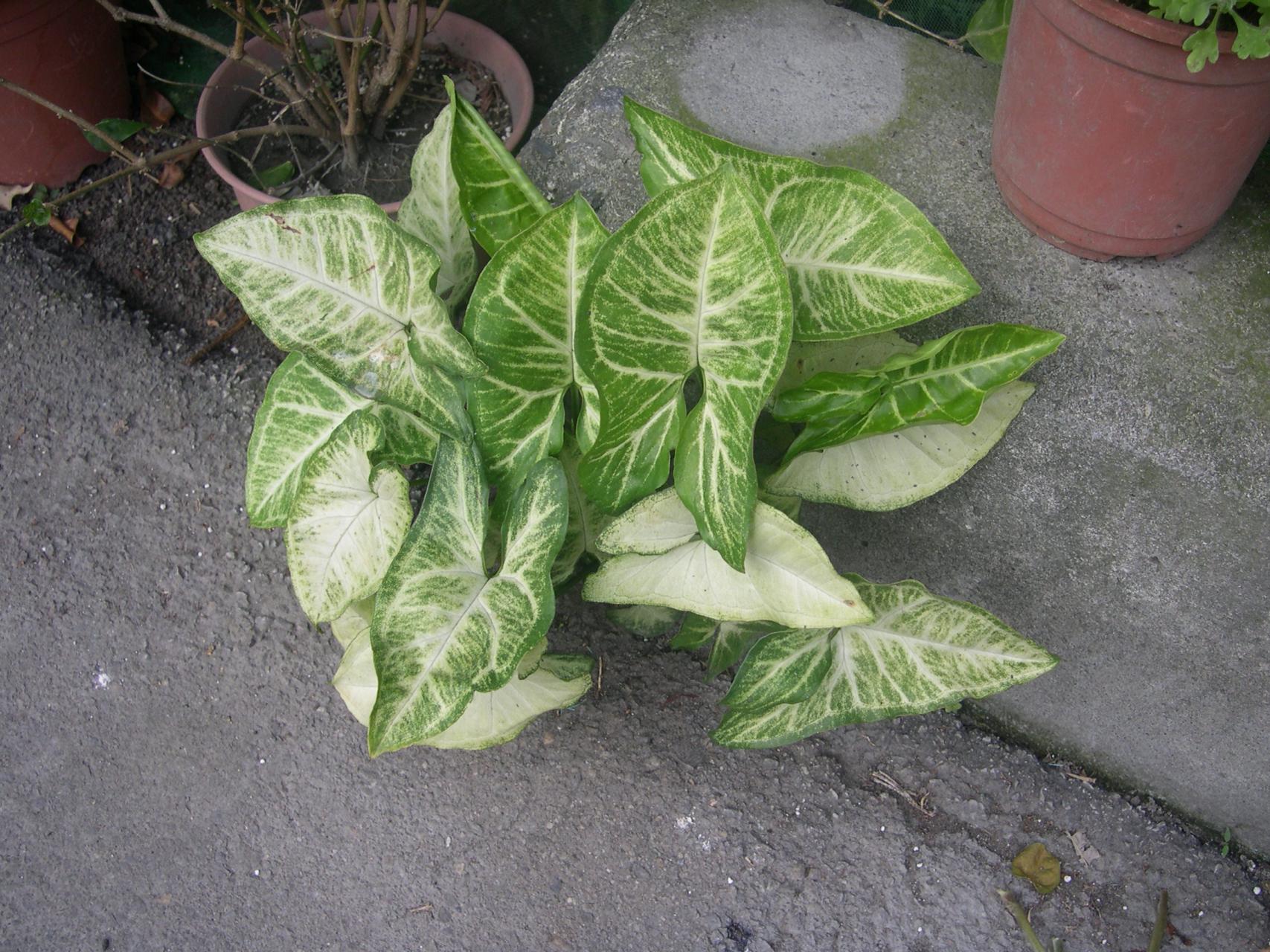
Botanical Name Syngonium podophyllum
Common Name Arrowhead vine
Plant Type Vine
Mature Size 3–6 ft. tall, 1–2 ft. wide
Sun Exposure Partial shade
Soil Type Moist but well-drained
Soil pH Neutral to acidic
Bloom Time Summer (rarely flowers)
Flower Color White
Hardiness Zones 10–12 (USDA)
Native Area South America, Mexico
Toxicity Toxic to dogs and cats
Arrowhead Vine Care
Arrowhead vine is a relatively easy houseplant to care for—it will thrive under the same conditions as its very popular relative, the philodendron. Arrowhead vines are climbers in the wild and will eventually grow from shade into full sun in the canopy of trees, with leaves maturing and gaining size as the plants gain altitude. As a houseplant, they're often used as trailing plants once mature and can be trained up a pole or moss stick for added visual interest. Alternately, you can pinch new growth to maintain the young plant's upright stems.
Tropical in nature, arrowhead vines are perfect for a sunroom or greenhouse conservatory where ample heat, light, and humidity will encourage their growth. Provide your arrowhead vine with the right growing conditions, and you will have a lush and healthy plant.
Light
Arrowhead vine likes bright light but no direct sun. Diffused light is best, as harsh rays can burn or bleach the delicate leaves and vines. Variegated colorways can handle a bit more direct sun, while deeper green varieties are better adapted to partial shade.
Soil
Plant your arrowhead vine in a traditional soil-based potting mix. Arrowhead vines are prone to root rot, so you'll want to make sure whichever potting soil you choose is well-draining. Additionally, consider planting your vine in a terracotta or clay vessel to wick away extra moisture from the soil.
Water
Water your arrowhead vine regularly during the spring and summer months, and reduce your watering cadence come winter. During the spring and summer, you want to allow your vine to dry out partially between waterings but never completely. Likewise, the plant should not be kept too wet, either.
Temperature and Humidity
True to its tropical nature, arrowhead vine prefers warm and humid conditions. If possible, maintain temperatures above 60 degrees Fahrenheit. While the plant can tolerate average humidity, it will thrive best with added moisture in the air. Consider keeping your plant somewhere in your home with naturally higher humidity (like a kitchen or bathroom), or utilize a method of increasing humidity, like a portable machine or placing a bed of wet river rocks beneath the pot.
Fertilizer
Feed your arrowhead vine once a month with liquid fertilizer throughout the spring, summer, and fall months. You can halt feeding throughout winter when the plant will naturally slow its growth.
Propagating Arrowhead Vine
Arrowhead vine plants root readily from stem cuttings and can easily be propagated in the spring or summer months. If your plant has aerial roots along the stem, take a section of the stem with attached roots to increase your odds of success.
To propagate arrowhead vine, place your cutting into a glass of water—within a few weeks, you'll notice new roots have begun to form. Wait at least a month until the roots have strengthened, topping off the water periodically. At that point, you can plant the cutting into the soil as you normally would.

Repotting Arrowhead Vine
These plants are aggressive, rapid-growing vines, so the frequency of repotting depends somewhat on how big you want the vine to get. Repot yearly for a larger vine. Otherwise, refresh potting media every spring and repot every other year to ensure the plant does not become root-bound.
Common Pests and Diseases
Arrowhead vine is relatively resistant to pests on its own. However, dwelling in the home amongst other plants can expose it to pests like spider mites, mealybugs, aphids, and scale. If you notice any of these afflictions, treat your plant immediately with neem oil or another natural solution.
The arrowhead vine's leaf structure changes as it matures, going from a simple arrow shape to a deeply lobed or divided mature leaf. Its leaves can vary in hue depending on their age, ranging from dark green and white to lime green and bright pink. Arrowhead vine is only viable outdoors in USDA hardiness zones 10 through 12, so in most locations in the United States, it is grown year-round as a houseplant. The vine does best if left relatively alone, making it a great pick for novice gardeners or those who just forget to tend to their in-home garden frequently.

Botanical Name Syngonium podophyllum
Common Name Arrowhead vine
Plant Type Vine
Mature Size 3–6 ft. tall, 1–2 ft. wide
Sun Exposure Partial shade
Soil Type Moist but well-drained
Soil pH Neutral to acidic
Bloom Time Summer (rarely flowers)
Flower Color White
Hardiness Zones 10–12 (USDA)
Native Area South America, Mexico
Toxicity Toxic to dogs and cats
Arrowhead Vine Care
Arrowhead vine is a relatively easy houseplant to care for—it will thrive under the same conditions as its very popular relative, the philodendron. Arrowhead vines are climbers in the wild and will eventually grow from shade into full sun in the canopy of trees, with leaves maturing and gaining size as the plants gain altitude. As a houseplant, they're often used as trailing plants once mature and can be trained up a pole or moss stick for added visual interest. Alternately, you can pinch new growth to maintain the young plant's upright stems.
Tropical in nature, arrowhead vines are perfect for a sunroom or greenhouse conservatory where ample heat, light, and humidity will encourage their growth. Provide your arrowhead vine with the right growing conditions, and you will have a lush and healthy plant.
Light
Arrowhead vine likes bright light but no direct sun. Diffused light is best, as harsh rays can burn or bleach the delicate leaves and vines. Variegated colorways can handle a bit more direct sun, while deeper green varieties are better adapted to partial shade.
Soil
Plant your arrowhead vine in a traditional soil-based potting mix. Arrowhead vines are prone to root rot, so you'll want to make sure whichever potting soil you choose is well-draining. Additionally, consider planting your vine in a terracotta or clay vessel to wick away extra moisture from the soil.
Water
Water your arrowhead vine regularly during the spring and summer months, and reduce your watering cadence come winter. During the spring and summer, you want to allow your vine to dry out partially between waterings but never completely. Likewise, the plant should not be kept too wet, either.
Temperature and Humidity
True to its tropical nature, arrowhead vine prefers warm and humid conditions. If possible, maintain temperatures above 60 degrees Fahrenheit. While the plant can tolerate average humidity, it will thrive best with added moisture in the air. Consider keeping your plant somewhere in your home with naturally higher humidity (like a kitchen or bathroom), or utilize a method of increasing humidity, like a portable machine or placing a bed of wet river rocks beneath the pot.
Fertilizer
Feed your arrowhead vine once a month with liquid fertilizer throughout the spring, summer, and fall months. You can halt feeding throughout winter when the plant will naturally slow its growth.
Propagating Arrowhead Vine
Arrowhead vine plants root readily from stem cuttings and can easily be propagated in the spring or summer months. If your plant has aerial roots along the stem, take a section of the stem with attached roots to increase your odds of success.
To propagate arrowhead vine, place your cutting into a glass of water—within a few weeks, you'll notice new roots have begun to form. Wait at least a month until the roots have strengthened, topping off the water periodically. At that point, you can plant the cutting into the soil as you normally would.

Repotting Arrowhead Vine
These plants are aggressive, rapid-growing vines, so the frequency of repotting depends somewhat on how big you want the vine to get. Repot yearly for a larger vine. Otherwise, refresh potting media every spring and repot every other year to ensure the plant does not become root-bound.
Common Pests and Diseases
Arrowhead vine is relatively resistant to pests on its own. However, dwelling in the home amongst other plants can expose it to pests like spider mites, mealybugs, aphids, and scale. If you notice any of these afflictions, treat your plant immediately with neem oil or another natural solution.
0
0
文章
Miss Chen
2021年06月02日

Distribution and habitat: Aloe aristata is a species of evergreen flowering perennial plant in the subfamily Asphodelaceae. It is native to mountains grassland of South Africa and is therefore best suited to warm, dry conditions. These plants can be found growing up to 2300m (7500 feet) above sea level in their natural habitat and is one of the hardest species within its genus. They have become increasingly rare in the wild through harvesting.
Description: Aloe aristata is a dwarf version of the Aloe genus. It is stemless with dark grey-green leaves densely packed in a rosette. Each leaf is about 15cm (6 inch) long and 2cm (0.8 inch) wide, spotted with tubercles. The margins of the leaves are lined with white horny materials and both the margins and the surfaces of the leaves are minutely toothed with short, soft white spines.
and has hard white edges and a bristle like growth from the leaf tip. Orange flowers, which appear on a 30cm (12 inch) stalk in early summer, lasting for several days. Mature plants produce many offsets.
Its fleshy leaves retain water allowing the plant to get through periods of drought without trouble. It is a small plant, usually growing to about 15 to 20cm (6-8 inch) in a tight rosette formation. Its nectar-rich, tubular orange flowers attract birds and bees.
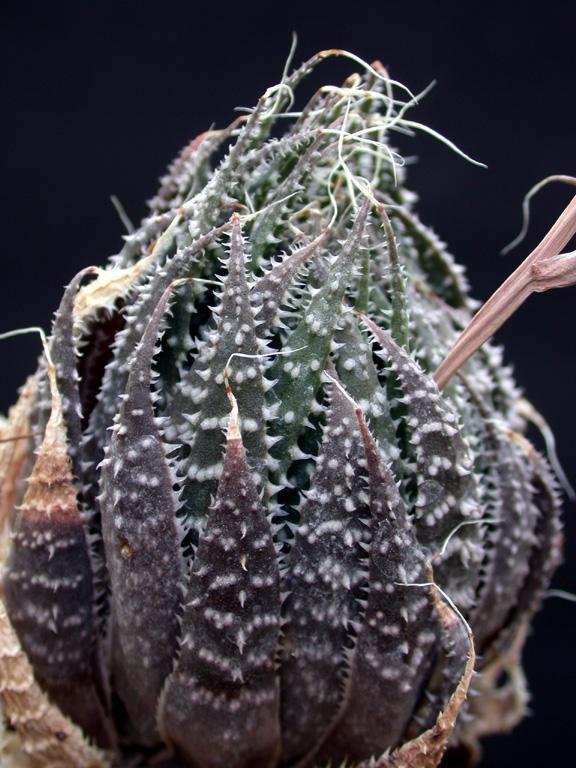
Houseplant care: Aloe aristata is a small hardy succulent plant popular as an indoor plant.
Light: Bright light suits Aloe aristata. It will not thrive if permanently placed at a distance from a window.
Temperature: Aloe aristata plants grow well in normal room temperatures and are tolerant of dry air. To encourage flowering, however, it is best to give the plants a short winter rest at a temperature of no more that 10°C (50°F).
Watering: During the active growth period water plentifully as often as necessary to keep the potting mixture thoroughly moist. During the rest period water only enough to prevent the potting mixture from drying out. Do not permit water to collect in the tight rosette.
Feeding: Apply standard liquid fertiliser every two weeks during the active growth period.
Potting and repotting: Use a soil based potting mixture. Most Aloe aristata should be moved into pots one size larger every spring. Keep these plants in shallow pots. When maximum convenient pot size has been reached, plants should be top dressed with fresh potting mixture once a year. To prevent rot, make sure that these plants which have tick basal leaves are never buried deeper than they were before. A sprinkling of coarse sand over the surface of the potting mixture helps to prevent rot points where fleshy leaves of these stemless plants touch the soil.
Gardening: In order to grow Aloe aristata in temperate climates they will need to be taken inside during the coldest weather and keep them in bright sunlight during the summer. This species is hardier than many other species within its genus, but will still appreciate the warmth. It requires very little maintenance, making it an ideal choice for novice gardeners.They flower freely in the summer and the soft-orange flowers are a wonderful addition to the arid garden.
Location: Aloe aristata can be place in full sun or semi-shade in hot climates.
Soil: Dry and well drained gritty soils are suitable for these plants. Sandy free draining soil will keep the Aloe aristata healthy. Use cactus compost or add sand to improve the garden soil drainage.
Irrigation: This genus is well known for its ease of cultivation, but they are sensitive to excessive irrigation. Provide regular watering in spring and summer to make the soil thoroughly moist then allow the soil to dry before watering again. In winter (during the dormant season) water sparingly or not at all, as it is prone to rotting; a thin layer of gravel on top of the soil will help to prevent this.
Fertilising: Feed Aloe aristata very little now and then during the active growth period.
Propagation: Aloe aristata produces offsets that can be taken from the base of a plant early in summer. These small new rosettes are often attached to the parent by a short underground stolon and may already have little roots, which should be retained for propagation propose.
Because very tiny offsets are hard to root, they should not be removed for planting until their leaves have begun to open into the characteristic rosette shape.
Offsets will root in two to three weeks in the standard potting mixture if some coarse sand is sprinkled at the base of the rosette to prevent rotting. Until offsets are well established, they should be provided with bright light without direct sunlight and they should be watered only enough to moisten the potting mixture, allowing the top two-thirds of the potting mixture to dry out between waterings.
Also, Aloe aristata can be propagated by seed sown in warm environment as soon as ripe.
Problems: Most likely to be caused by incorrect watering. A properly watered Aloe aristata plant can resist most pests and diseases.
Wilting is the result of inadequate water in summer.
Yellowing leaves accompanied by rotting at the base is the result of overwatering plants kept in cool winter conditions.
Mealy bugs and root mealy bugs ca be troublesome. The former hide deep in the crevices of rosette foliage and the latter generally bury themselves in the roots, just below the surface of the potting mixture.
Treatment: Remove visible bugs with a toothpick or a damp cloth or swab them off foliage with a small, stiff paintbrush dipped in methylated spirit or an insecticide solution. Then spray all top growth with an appropriate pesticide. Alternatively, place granules of a systemic pesticide in the potting mixture. During the next month examine plants weekly for traces of reinfestation.

Scale insects can also infest this plant.
Treatment: Scale can be easily controlled by physical removal, wash off with high pressure jet of water or scrape off with cotton wool buds or by chemical control with appropriate pesticide.
Note: When not in bloom, Aloe aristata is similar to and often confused with Haworthia fasciata.
Uses: Aloe aristata is cultivated as a garden plant, but as it requires winter protection is grown under glass in temperate regions. Left to grow by themselves, they quickly form a large clump and are very effective in a large xeriphytic landscape if planted en masse about 0.5m (2 feet) apart, so that as the clumps grow and spread they form an expansive globular carpet.
Also, Aloe aristata is often grown indoors as a window-ledge succulent plant.
SUMMARY:
CHARACTERISTICS:
Foliage – variegated
Features – flowers
Shape – rosette
Height: 15 to 20cm (6-8 inch)
PROPER CARE:
Watering in rest period – sparingly
Watering in active growth period – plentifully
Light – bright filtered
Temperature in rest period – min 7°C max 10°C (45-50°F)
Temperature in active growth period – min 16°C max 24°C (61-75°F)
Humidity – low
Hardiness zone: 7b-11
Description: Aloe aristata is a dwarf version of the Aloe genus. It is stemless with dark grey-green leaves densely packed in a rosette. Each leaf is about 15cm (6 inch) long and 2cm (0.8 inch) wide, spotted with tubercles. The margins of the leaves are lined with white horny materials and both the margins and the surfaces of the leaves are minutely toothed with short, soft white spines.
and has hard white edges and a bristle like growth from the leaf tip. Orange flowers, which appear on a 30cm (12 inch) stalk in early summer, lasting for several days. Mature plants produce many offsets.
Its fleshy leaves retain water allowing the plant to get through periods of drought without trouble. It is a small plant, usually growing to about 15 to 20cm (6-8 inch) in a tight rosette formation. Its nectar-rich, tubular orange flowers attract birds and bees.

Houseplant care: Aloe aristata is a small hardy succulent plant popular as an indoor plant.
Light: Bright light suits Aloe aristata. It will not thrive if permanently placed at a distance from a window.
Temperature: Aloe aristata plants grow well in normal room temperatures and are tolerant of dry air. To encourage flowering, however, it is best to give the plants a short winter rest at a temperature of no more that 10°C (50°F).
Watering: During the active growth period water plentifully as often as necessary to keep the potting mixture thoroughly moist. During the rest period water only enough to prevent the potting mixture from drying out. Do not permit water to collect in the tight rosette.
Feeding: Apply standard liquid fertiliser every two weeks during the active growth period.
Potting and repotting: Use a soil based potting mixture. Most Aloe aristata should be moved into pots one size larger every spring. Keep these plants in shallow pots. When maximum convenient pot size has been reached, plants should be top dressed with fresh potting mixture once a year. To prevent rot, make sure that these plants which have tick basal leaves are never buried deeper than they were before. A sprinkling of coarse sand over the surface of the potting mixture helps to prevent rot points where fleshy leaves of these stemless plants touch the soil.
Gardening: In order to grow Aloe aristata in temperate climates they will need to be taken inside during the coldest weather and keep them in bright sunlight during the summer. This species is hardier than many other species within its genus, but will still appreciate the warmth. It requires very little maintenance, making it an ideal choice for novice gardeners.They flower freely in the summer and the soft-orange flowers are a wonderful addition to the arid garden.
Location: Aloe aristata can be place in full sun or semi-shade in hot climates.
Soil: Dry and well drained gritty soils are suitable for these plants. Sandy free draining soil will keep the Aloe aristata healthy. Use cactus compost or add sand to improve the garden soil drainage.
Irrigation: This genus is well known for its ease of cultivation, but they are sensitive to excessive irrigation. Provide regular watering in spring and summer to make the soil thoroughly moist then allow the soil to dry before watering again. In winter (during the dormant season) water sparingly or not at all, as it is prone to rotting; a thin layer of gravel on top of the soil will help to prevent this.
Fertilising: Feed Aloe aristata very little now and then during the active growth period.
Propagation: Aloe aristata produces offsets that can be taken from the base of a plant early in summer. These small new rosettes are often attached to the parent by a short underground stolon and may already have little roots, which should be retained for propagation propose.
Because very tiny offsets are hard to root, they should not be removed for planting until their leaves have begun to open into the characteristic rosette shape.
Offsets will root in two to three weeks in the standard potting mixture if some coarse sand is sprinkled at the base of the rosette to prevent rotting. Until offsets are well established, they should be provided with bright light without direct sunlight and they should be watered only enough to moisten the potting mixture, allowing the top two-thirds of the potting mixture to dry out between waterings.
Also, Aloe aristata can be propagated by seed sown in warm environment as soon as ripe.
Problems: Most likely to be caused by incorrect watering. A properly watered Aloe aristata plant can resist most pests and diseases.
Wilting is the result of inadequate water in summer.
Yellowing leaves accompanied by rotting at the base is the result of overwatering plants kept in cool winter conditions.
Mealy bugs and root mealy bugs ca be troublesome. The former hide deep in the crevices of rosette foliage and the latter generally bury themselves in the roots, just below the surface of the potting mixture.
Treatment: Remove visible bugs with a toothpick or a damp cloth or swab them off foliage with a small, stiff paintbrush dipped in methylated spirit or an insecticide solution. Then spray all top growth with an appropriate pesticide. Alternatively, place granules of a systemic pesticide in the potting mixture. During the next month examine plants weekly for traces of reinfestation.

Scale insects can also infest this plant.
Treatment: Scale can be easily controlled by physical removal, wash off with high pressure jet of water or scrape off with cotton wool buds or by chemical control with appropriate pesticide.
Note: When not in bloom, Aloe aristata is similar to and often confused with Haworthia fasciata.
Uses: Aloe aristata is cultivated as a garden plant, but as it requires winter protection is grown under glass in temperate regions. Left to grow by themselves, they quickly form a large clump and are very effective in a large xeriphytic landscape if planted en masse about 0.5m (2 feet) apart, so that as the clumps grow and spread they form an expansive globular carpet.
Also, Aloe aristata is often grown indoors as a window-ledge succulent plant.
SUMMARY:
CHARACTERISTICS:
Foliage – variegated
Features – flowers
Shape – rosette
Height: 15 to 20cm (6-8 inch)
PROPER CARE:
Watering in rest period – sparingly
Watering in active growth period – plentifully
Light – bright filtered
Temperature in rest period – min 7°C max 10°C (45-50°F)
Temperature in active growth period – min 16°C max 24°C (61-75°F)
Humidity – low
Hardiness zone: 7b-11
0
0
文章
莹723
2021年02月17日

Sowing seeds is something that some gardeners avoid, but it’s easy when you know how. You just need to give seeds the right conditions, and they’ll germinate.
Germination is triggered by the correct combination of light levels, temperature and moisture – get these right, and the seed will start to grow.
We show you when and where to sow all kinds of seeds, indoors and outdoors, in this sowing guide.

1.Hardy annuals
Including: calendula, cornflower, nasturtium, poppy, sunflower, sweet pea.
Sow under glass: Feb-Mar (soil temp 8-12°C).
Sow outdoors: Mar-April (soil temp 6-12°C).
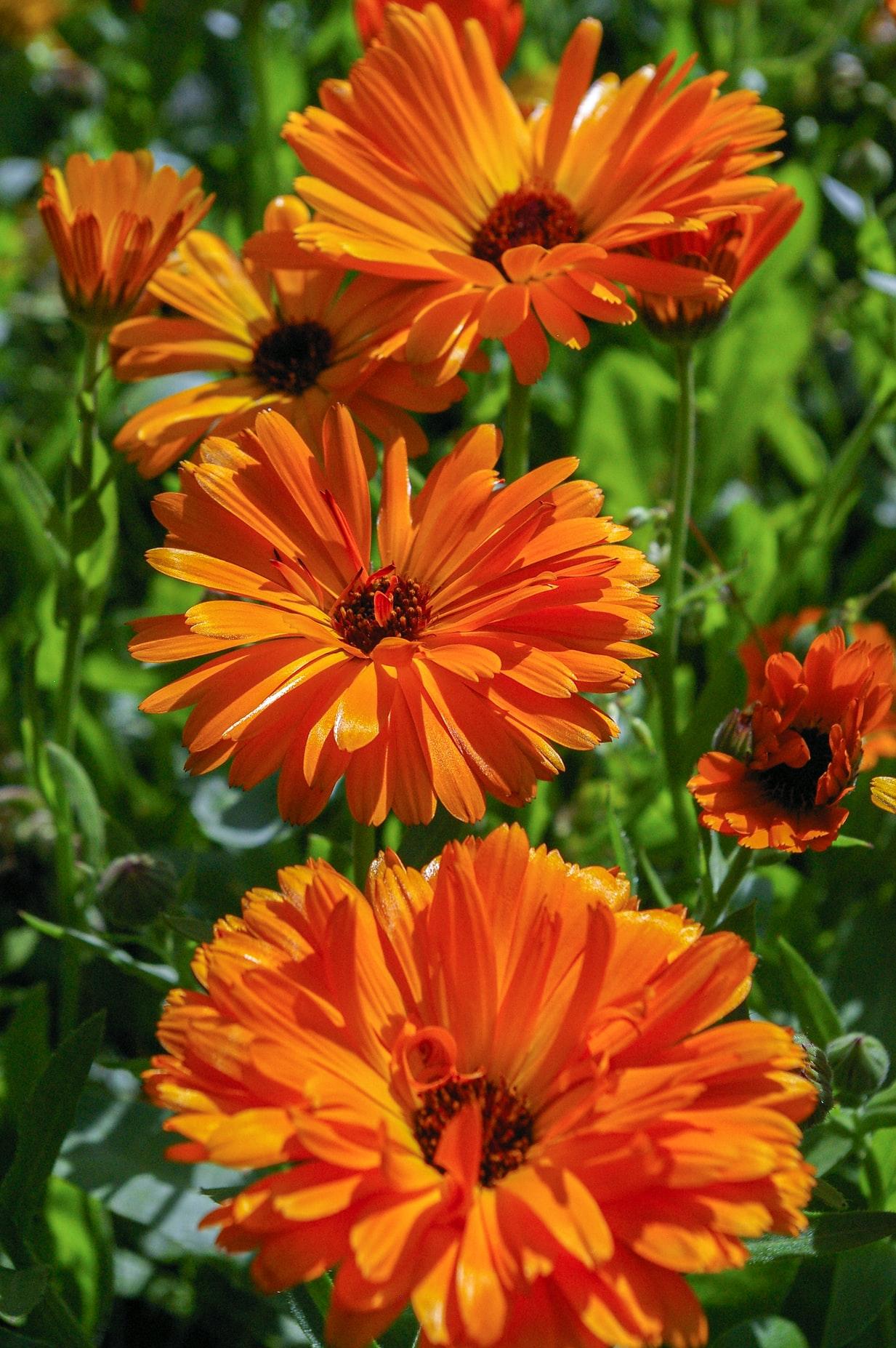
2.Hardy salads and veg
Including: beetroot, broad bean, chard, lettuce, pea, spring onion, radish, rocket.
Sow under glass: Feb-April (soil temp 10-18°C).
Sow outdoors: March-Sep (soil temp 8-18°C).

3.Half-hardy flowers
Including: cosmos, lobelia, morning glory, nicotiana, snapdragon.
Sow under glass: Mar (soil temp 16-24°C) – seeds must be sown indoors.
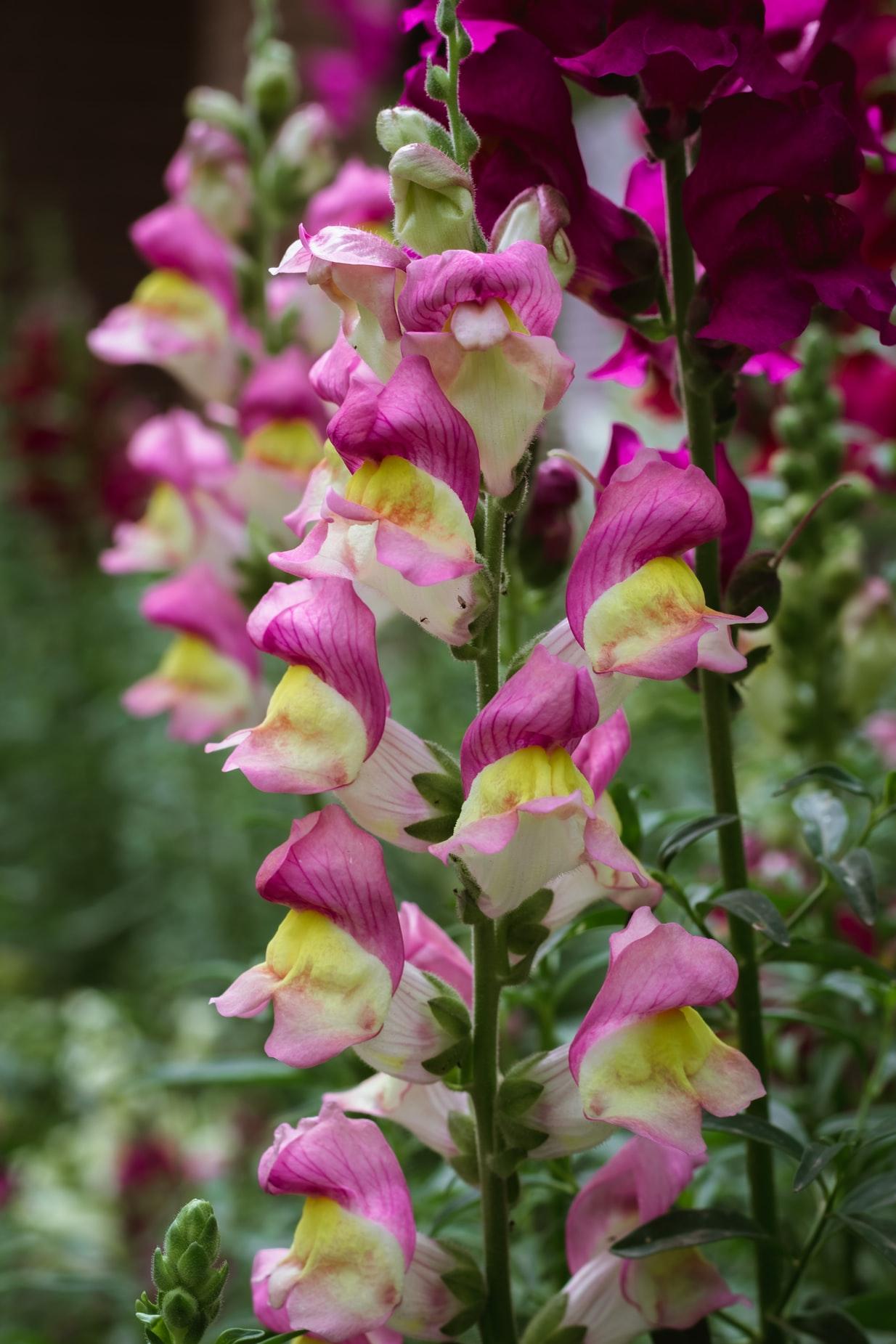
4.Tender perennials
Including: begonias, dahlia, fuchsia, heliotrope, pelargonium, salvia.
Sow under glass: Jan-Feb (soil temp 18-24°C) – must be sown under cover.

5.Frost-tender veg
Including: aubergine, chillies, courgette, French/runner bean, pepper, pumpkin, sweetcorn, tomato.
Sow under glass: April (soil temp 16-28°C).
Sow outdoors: May-June (soil temp at least 10°C).

6.Hardy perennials
Including: aquilegia, delphinium, echinacea, hellebore, lupin, rudbeckia, verbascum.
Sow under glass: Jan-Feb (soil temp 18-21°C).
Sow outdoors: April-June (soil temp at least 10°C).

7.Polyanthus
Including: campanula, forget-me-not, foxglove, polyanthus, sweet william, wallflower, winter pansy.
Sow under glass: June (soil temp 12-18°C).
Sow outdoors: April-June (soil temp 10-18°C).

8.Trees and shrubs
Including: abutilon, acer, bonsai, cotoneaster, cytisus (broom), hawthorn, sorbus.
Sow under glass: Sep-Mar (soil temp 4-10°C).
Sow outdoors: Sep-Mar (soil temp 0-12°C).

Germination is triggered by the correct combination of light levels, temperature and moisture – get these right, and the seed will start to grow.
We show you when and where to sow all kinds of seeds, indoors and outdoors, in this sowing guide.

1.Hardy annuals
Including: calendula, cornflower, nasturtium, poppy, sunflower, sweet pea.
Sow under glass: Feb-Mar (soil temp 8-12°C).
Sow outdoors: Mar-April (soil temp 6-12°C).

2.Hardy salads and veg
Including: beetroot, broad bean, chard, lettuce, pea, spring onion, radish, rocket.
Sow under glass: Feb-April (soil temp 10-18°C).
Sow outdoors: March-Sep (soil temp 8-18°C).

3.Half-hardy flowers
Including: cosmos, lobelia, morning glory, nicotiana, snapdragon.
Sow under glass: Mar (soil temp 16-24°C) – seeds must be sown indoors.

4.Tender perennials
Including: begonias, dahlia, fuchsia, heliotrope, pelargonium, salvia.
Sow under glass: Jan-Feb (soil temp 18-24°C) – must be sown under cover.

5.Frost-tender veg
Including: aubergine, chillies, courgette, French/runner bean, pepper, pumpkin, sweetcorn, tomato.
Sow under glass: April (soil temp 16-28°C).
Sow outdoors: May-June (soil temp at least 10°C).

6.Hardy perennials
Including: aquilegia, delphinium, echinacea, hellebore, lupin, rudbeckia, verbascum.
Sow under glass: Jan-Feb (soil temp 18-21°C).
Sow outdoors: April-June (soil temp at least 10°C).

7.Polyanthus
Including: campanula, forget-me-not, foxglove, polyanthus, sweet william, wallflower, winter pansy.
Sow under glass: June (soil temp 12-18°C).
Sow outdoors: April-June (soil temp 10-18°C).

8.Trees and shrubs
Including: abutilon, acer, bonsai, cotoneaster, cytisus (broom), hawthorn, sorbus.
Sow under glass: Sep-Mar (soil temp 4-10°C).
Sow outdoors: Sep-Mar (soil temp 0-12°C).

0
0
文章
莹723
2020年11月04日

Bottle gardens, or terrariums, are enjoying a revival, and they’re easy to create.The key is to combine small plants that thrive in similar growing conditions – usually either damp shade or drought.
You can plant a bottle garden in virtually any glass vessel, though closed ones are best for moisture lovers and open ones best for plants used to drier conditions. Don’t worry if you can’t find what we used – look in charity shops, garden centres, your kitchen cupboard or on the internet for something that appeals.

You Will Need
•Vintage glass bottle
•Horticultural grit
•Peat free houseplant compost
•Moss, (from the lawn)
•Spathiphyllum 'Chopin'
•Fittonia verschaffeltii
•Syngonium 'White Butterfly'
•Chlorophytum comosum 'Ocean'
•Peperomia rotundifolia

Total time:
20 minutes
Step 1
Put 5cm of horticultural grit in the bottom of the bottle for drainage. Add houseplant compost till the bottle is about a third full – breaking up any lumps with your hands. Choose lush foliage plants that thrive in low light and humidity.
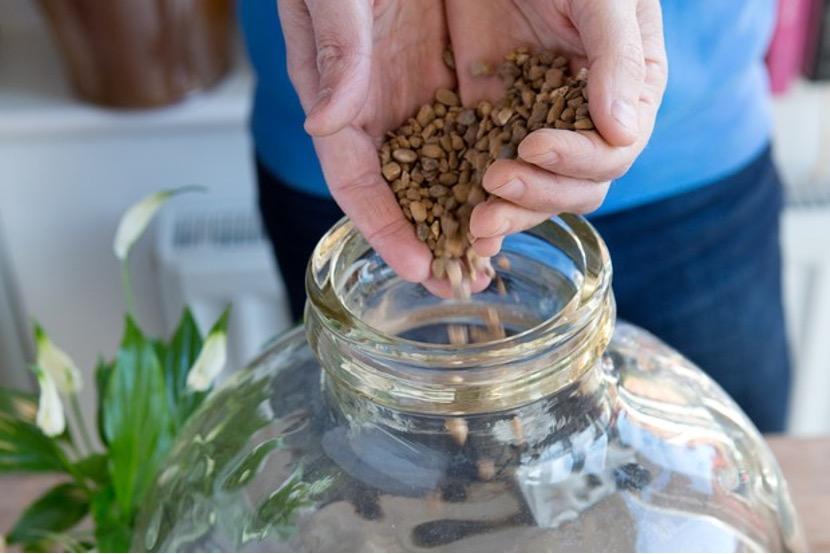
Step 2
Position the plants one at a time, planting them as you would in a container – firm the compost around them. Fill gaps between plants with a layer of moss.

Step 3
Water sparingly down the sides of the bottle as the curved sides will prevent a lot of evaporation. Ensure the compost doesn’t dry out or become saturated with water. Place in a bright spot out of direct sunlight.
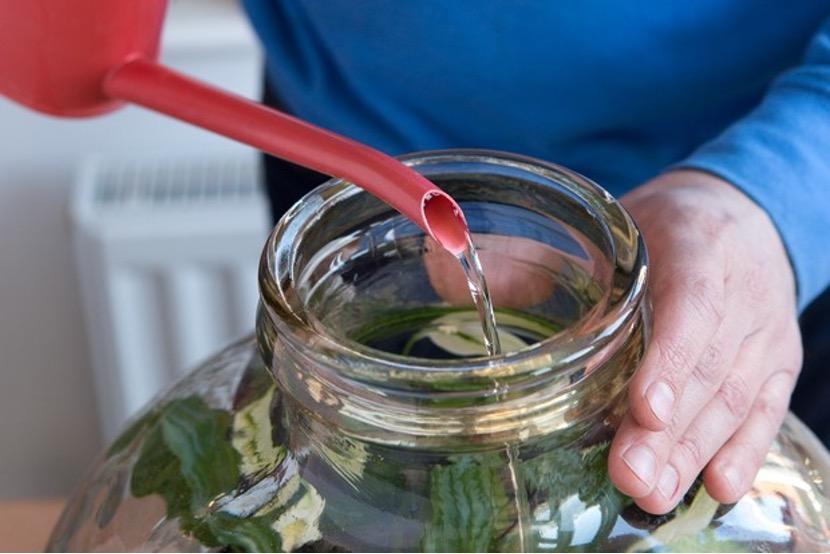
Alternative plants for a bottle garden
• Maidenhair fern (Adiantum raddianum)
• Golden polypody (Phlebodium aureum)
• Hares foot fern (Humata tyermannii)
• Mind-your-own-business (Soleirolia soleirolii)
• Centella (Centella asiatica)
• Cacti and succulents
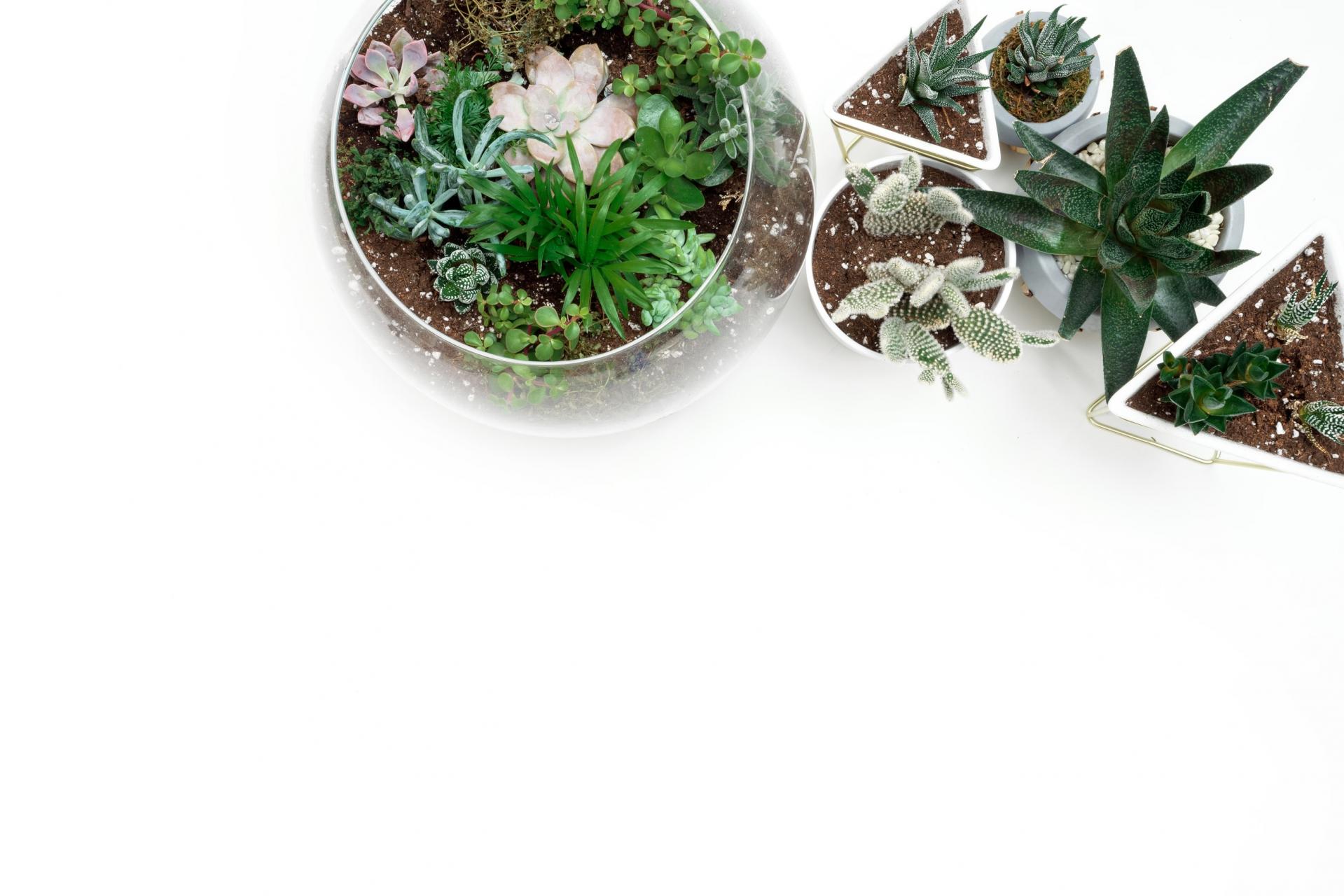
You can plant a bottle garden in virtually any glass vessel, though closed ones are best for moisture lovers and open ones best for plants used to drier conditions. Don’t worry if you can’t find what we used – look in charity shops, garden centres, your kitchen cupboard or on the internet for something that appeals.

You Will Need
•Vintage glass bottle
•Horticultural grit
•Peat free houseplant compost
•Moss, (from the lawn)
•Spathiphyllum 'Chopin'
•Fittonia verschaffeltii
•Syngonium 'White Butterfly'
•Chlorophytum comosum 'Ocean'
•Peperomia rotundifolia

Total time:
20 minutes
Step 1
Put 5cm of horticultural grit in the bottom of the bottle for drainage. Add houseplant compost till the bottle is about a third full – breaking up any lumps with your hands. Choose lush foliage plants that thrive in low light and humidity.

Step 2
Position the plants one at a time, planting them as you would in a container – firm the compost around them. Fill gaps between plants with a layer of moss.

Step 3
Water sparingly down the sides of the bottle as the curved sides will prevent a lot of evaporation. Ensure the compost doesn’t dry out or become saturated with water. Place in a bright spot out of direct sunlight.

Alternative plants for a bottle garden
• Maidenhair fern (Adiantum raddianum)
• Golden polypody (Phlebodium aureum)
• Hares foot fern (Humata tyermannii)
• Mind-your-own-business (Soleirolia soleirolii)
• Centella (Centella asiatica)
• Cacti and succulents

0
0
文章
莹723
2020年09月25日

Cactus plants, or cacti, make excellent indoor plants. Like succulents, they’re used to the hot, sunny, dry conditions of desert. Their leafless stems are designed to store water, so they can cope with drought. As such they need very little watering and can even rot if given too much. Cacti can be grown in pots or terrariums for years. They have different shapes and sizes and if you’re lucky, they bear delightful, colored flowers in summer.
1.How to plant cacti
Always plant cacti with care. The spines can prick and hurt your skin. It’s a good idea to use common kitchen items such as a thick tea towel, spoon and fork to help you.
Mulch with a layer of horticultural grit or pebbles to complete the look of the pot display. This also prevents water splashing back on the cactus.

2.How to propagate cacti
Cactus can be grown from seed although it can take several years for plants to reach a decent size. You can buy mixed cactus seed cheaply, and it’s fun to see which cactus varieties you end up with.
To grow cactus from seed, fill a pot with a moist, gritty, free-draining compost, firm down and level. Scatter cactus seeds over the surface, taking care not to sow them too thickly. Then, gently sprinkle a thin layer of vermiculite or fine grit over the seeds. Cover the pot with a clear plastic bag to preserve soil moisture, and leave the in a greenhouse or on a warm windowsill. You may need to find an alternative spot for them in winter if the windowsill becomes too cold.
Some cacti can be propagated from cuttings. Others bear offsets, which can simply be snipped off the plant and potted on.

3.Caring for cactus plants
In summer, water cacti no more than once a week. A good watering less often is better than a little-and-often approach. You shouldn’t need to water cacti at all in the coldest months.
Repot cacti every couple of years, to give them fresh compost – you won’t necessarily need to pot them into a larger pot.

4.Growing cactus plants: problem solving
Cactus plants are usually trouble free. If overwatered or not given enough light they can rot at the base. This is usually fatal for the plants.
Cactus plants can develop spindly growth but it’s easy to rectify.
5.Cactus varieties to grow
Echinocactus grusonii – golden barrel cactus is globe-shaped but eventually grows tall. Native to Mexico, it bears bright green stems with spiked ribs. Bright yellow flowers appear in summer.
Gymnocalycium paraguayense – a variable cactus with flattened spines. It produces creamy white flowers in spring and summer.
Mammillaria spinosissima – a globe-shaped cactus with bright pink, funnel-shaped flowers. Its central spines are a reddish-brown or yellow.
Rebutia krainziana – a clump-forming barrel cactus, forming dark green stems up to 7cm in diameter, with contrasting small, white areoles and spines. In late spring large, yellow or red flowers develop around the main stem, forming a tight clump.
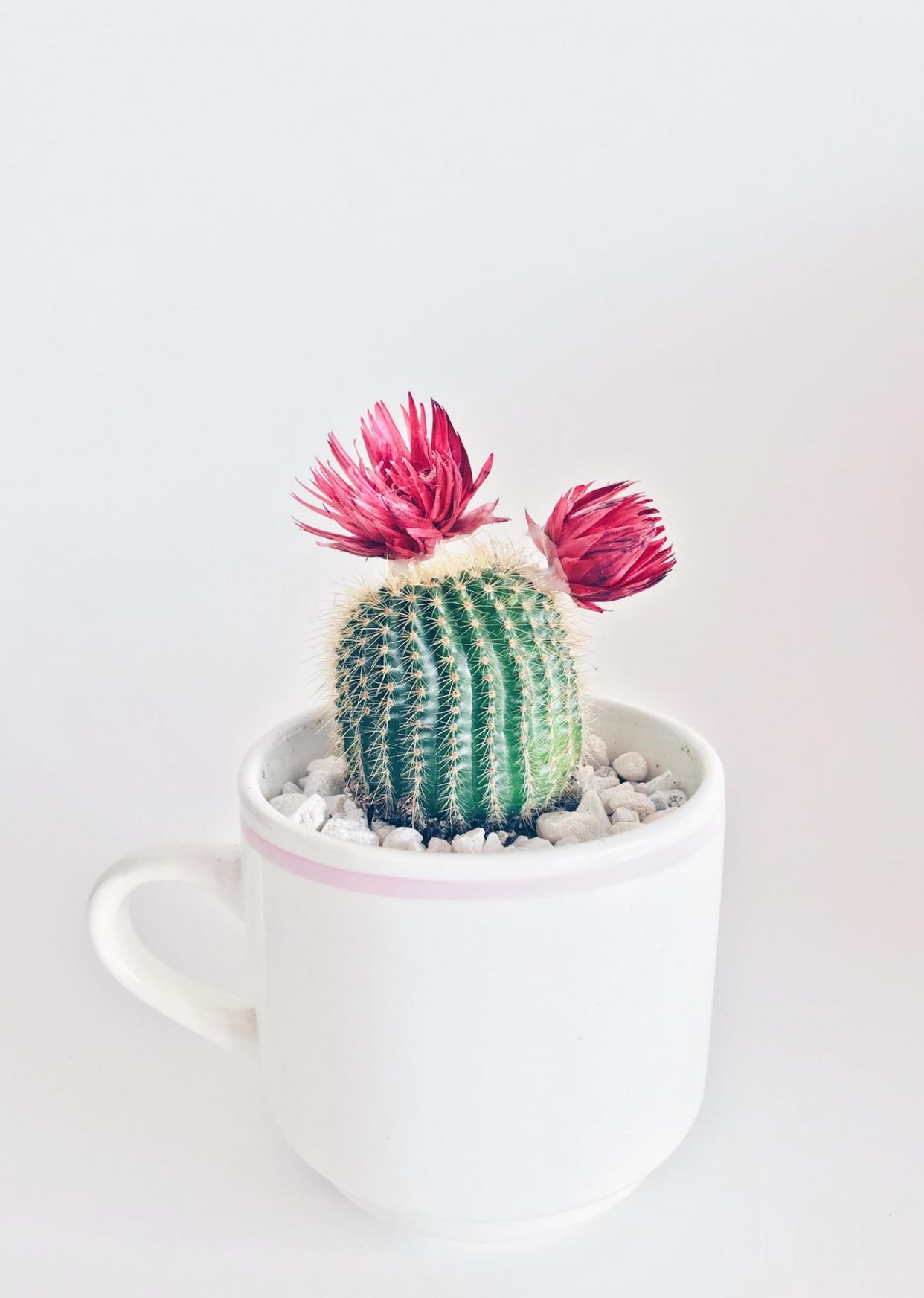
1.How to plant cacti
Always plant cacti with care. The spines can prick and hurt your skin. It’s a good idea to use common kitchen items such as a thick tea towel, spoon and fork to help you.
Mulch with a layer of horticultural grit or pebbles to complete the look of the pot display. This also prevents water splashing back on the cactus.

2.How to propagate cacti
Cactus can be grown from seed although it can take several years for plants to reach a decent size. You can buy mixed cactus seed cheaply, and it’s fun to see which cactus varieties you end up with.
To grow cactus from seed, fill a pot with a moist, gritty, free-draining compost, firm down and level. Scatter cactus seeds over the surface, taking care not to sow them too thickly. Then, gently sprinkle a thin layer of vermiculite or fine grit over the seeds. Cover the pot with a clear plastic bag to preserve soil moisture, and leave the in a greenhouse or on a warm windowsill. You may need to find an alternative spot for them in winter if the windowsill becomes too cold.
Some cacti can be propagated from cuttings. Others bear offsets, which can simply be snipped off the plant and potted on.

3.Caring for cactus plants
In summer, water cacti no more than once a week. A good watering less often is better than a little-and-often approach. You shouldn’t need to water cacti at all in the coldest months.
Repot cacti every couple of years, to give them fresh compost – you won’t necessarily need to pot them into a larger pot.

4.Growing cactus plants: problem solving
Cactus plants are usually trouble free. If overwatered or not given enough light they can rot at the base. This is usually fatal for the plants.
Cactus plants can develop spindly growth but it’s easy to rectify.
5.Cactus varieties to grow
Echinocactus grusonii – golden barrel cactus is globe-shaped but eventually grows tall. Native to Mexico, it bears bright green stems with spiked ribs. Bright yellow flowers appear in summer.
Gymnocalycium paraguayense – a variable cactus with flattened spines. It produces creamy white flowers in spring and summer.
Mammillaria spinosissima – a globe-shaped cactus with bright pink, funnel-shaped flowers. Its central spines are a reddish-brown or yellow.
Rebutia krainziana – a clump-forming barrel cactus, forming dark green stems up to 7cm in diameter, with contrasting small, white areoles and spines. In late spring large, yellow or red flowers develop around the main stem, forming a tight clump.

0
0
文章
ritau
2020年07月19日

Cacti are typically desert-dwelling plants that thrive in dry and hot conditions, but these plants also make excellent indoor houseplants. Cacti are quite low-maintenance and need less care than many other houseplants, making them an ideal plant for new gardeners and a great housewarming gift. The secrets to growing healthy cacti indoors include providing them with plenty of sunlight, not overwatering, and using the right soil.
1. Take a cutting from a healthy cactus. You can grow new cacti from a pup that shoots off of a healthy mother plant. Choose a pup that’s plump, unblemished, and healthy. Gently cut or break off an entire pup from the plant. You can also buy cacti at local nurseries, home stores, and garden centers.
2. Let the wound heal. Transfer the cutting to a sunny windowsill. Lay the cutting down flat and leave it for about two days. This will give the wound time to form a callous. If you don’t let the wound heal before planting, the cutting will likely rot.
3. Select a pot for the cactus. The most important thing to remember when choosing a pot for a cactus is drainage. Find a pot with drainage holes in the bottom that will allow excess water to drain out. Cacti also do well in smaller pots, so choose a pot that’s about twice the size of the plant. You can use clay or plastic pots for cacti. Plastic pots are lighter and cheaper, but heavier clay pots are better for large or top-heavy plants.

4. Fill the pot with a cactus-specific potting soil. Cacti need soil that drains very quickly, so choose a medium that’s specific for these types of plants. For even better drainage, mix two parts of the cactus potting soil with one part lava rock pebbles or pearlite.Cacti that sit in wet soil are prone to fungal and bacterial growth.
5. Plant the cutting in the soil. Place the stem or leaf cutting callous-down in the potting soil. Push the cutting in just deep enough so that it will stand up on its own. Use your hands to gently firm the soil around the cutting to stabilize it.
6. Mist the soil. Moisten the soil to provide the cactus with extra water, but don’t soak the soil. Until roots and new growth start to form, only mist the cutting lightly when the soil feels dry. Otherwise, the cutting may rot.
7. Keep the cutting in a bright location. Transfer the cutting to a windowsill or other area that gets lots of bright but indirect sunlight. Too much direct sun can damage a new cutting. Leave the cutting in this location for a month or two, until new growth starts to appear.

1. Take a cutting from a healthy cactus. You can grow new cacti from a pup that shoots off of a healthy mother plant. Choose a pup that’s plump, unblemished, and healthy. Gently cut or break off an entire pup from the plant. You can also buy cacti at local nurseries, home stores, and garden centers.
2. Let the wound heal. Transfer the cutting to a sunny windowsill. Lay the cutting down flat and leave it for about two days. This will give the wound time to form a callous. If you don’t let the wound heal before planting, the cutting will likely rot.
3. Select a pot for the cactus. The most important thing to remember when choosing a pot for a cactus is drainage. Find a pot with drainage holes in the bottom that will allow excess water to drain out. Cacti also do well in smaller pots, so choose a pot that’s about twice the size of the plant. You can use clay or plastic pots for cacti. Plastic pots are lighter and cheaper, but heavier clay pots are better for large or top-heavy plants.

4. Fill the pot with a cactus-specific potting soil. Cacti need soil that drains very quickly, so choose a medium that’s specific for these types of plants. For even better drainage, mix two parts of the cactus potting soil with one part lava rock pebbles or pearlite.Cacti that sit in wet soil are prone to fungal and bacterial growth.
5. Plant the cutting in the soil. Place the stem or leaf cutting callous-down in the potting soil. Push the cutting in just deep enough so that it will stand up on its own. Use your hands to gently firm the soil around the cutting to stabilize it.
6. Mist the soil. Moisten the soil to provide the cactus with extra water, but don’t soak the soil. Until roots and new growth start to form, only mist the cutting lightly when the soil feels dry. Otherwise, the cutting may rot.
7. Keep the cutting in a bright location. Transfer the cutting to a windowsill or other area that gets lots of bright but indirect sunlight. Too much direct sun can damage a new cutting. Leave the cutting in this location for a month or two, until new growth starts to appear.

0
0
文章
ritau
2020年04月25日

1. Choose houseplants suited for your available light conditions.
The first step in preventing insects actually arises when you choose your plants. Make sure each houseplant is well suited to the amount of light it will receive once in position. Plants in unfavorable light conditions are subjected to stress, which makes them more susceptible to insect infestation.
2. Make sure your houseplants are potted in sterile soil.
While bacteria, fungus, and insects are a vital component of outdoor soil health, houseplants are better planted in store bought potting mix, which will generally be sterile. Using outdoor garden soil can introduce insect larvae into your houseplants.
3. Clean your houseplants regularly.
Dust buildup on your houseplant leaves often contains organic compounds (like skin cells or pet hair) that insects can feed on. Furthermore, insects like mites thrive in thick layers of dust and will be less likely to infest a clean plant.
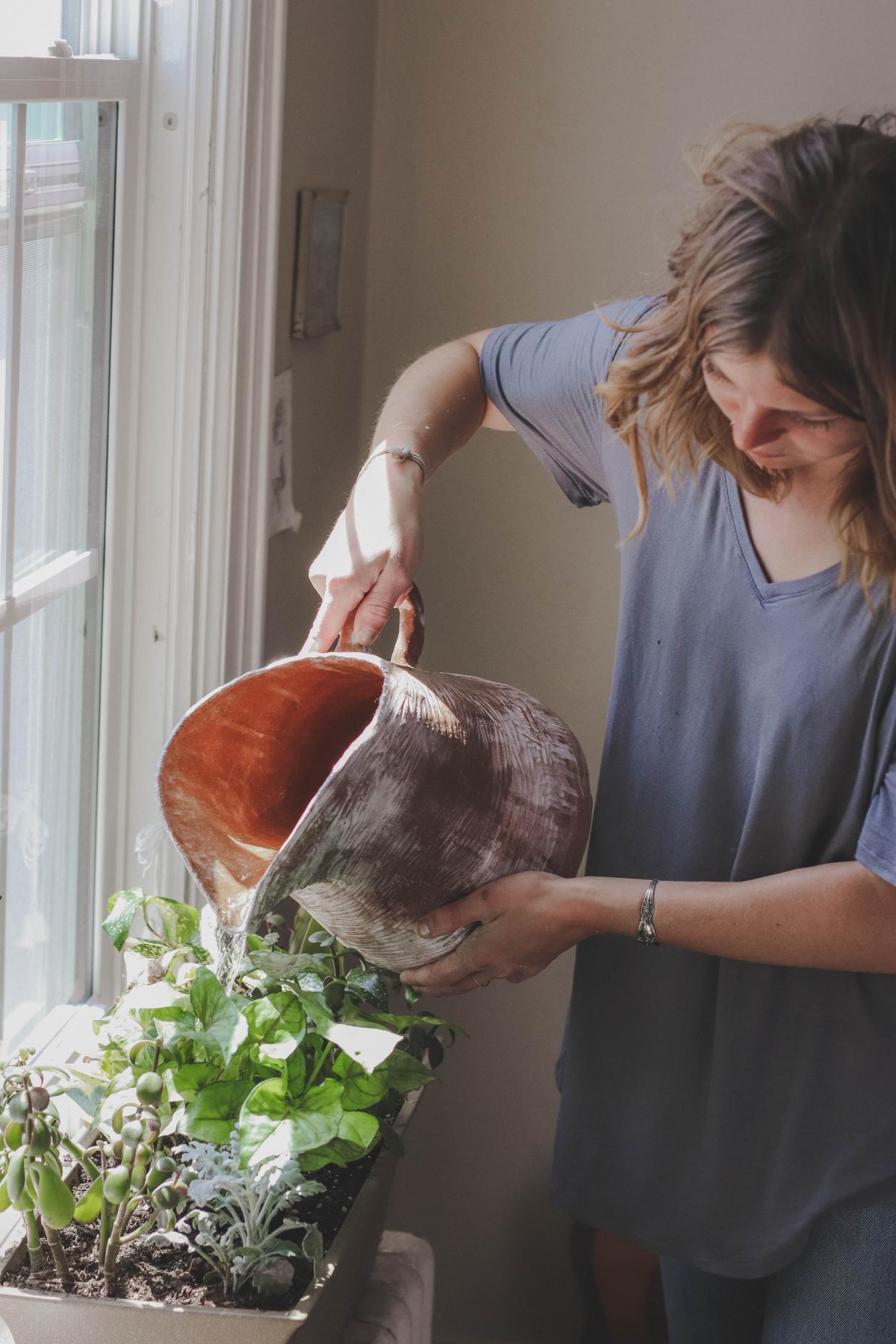
4. Inspect your plants regularly for insect damage.
This may sound obvious, but in fact most insect infestations can be mitigated if you are monitoring your houseplants closely enough to catch the early signs. Discolored, speckled, mottled, and chewed up leaves can indicate insect activity. Of course, you may also be able to see the insects themselves as well as their eggs, larvae, or cast off skins.
5. Control existing insect infestations as well as possible. Even if you take the precautionary steps above, you may still find yourself faced with insects in your houseplants. There are several method you can use to kill and remove insects.
*Sticky traps can be used to control infestations of flying insects such as fruit flies, gnats, and winged aphids. These traps are usually yellow in appearance and can be hung near the infested houseplant.
*Pruning can help control isolated insect infestations. If you notice that most of the insects are concentrated on a few leaves of a plant, prune these leaves away and throw them out.
*Wash small insects away with soapy water. Small insects like aphids and mealybugs can be removed by rubbing the plant's leaves with a cloth moistened with soapy water.
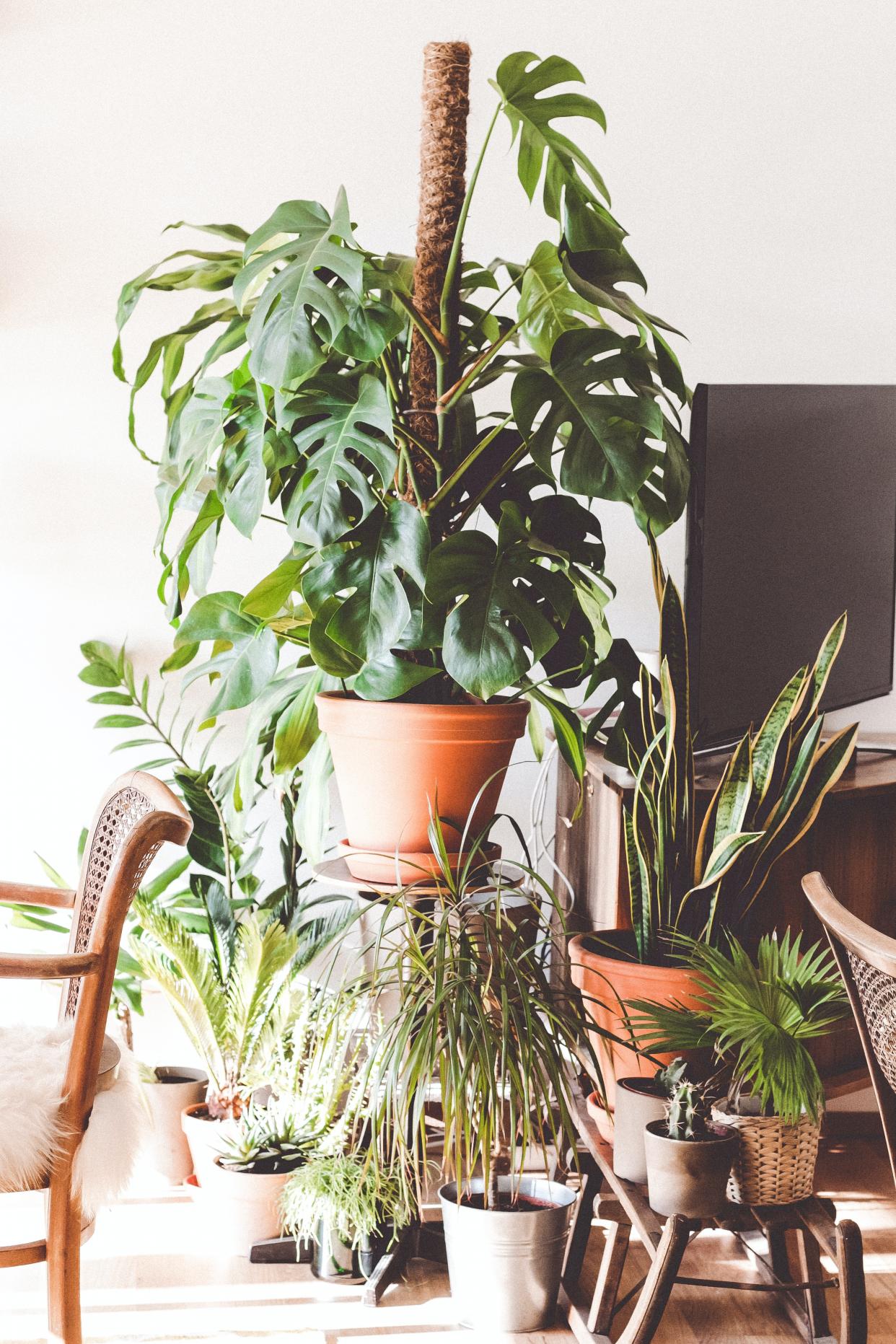
6. Know when to give up on an infested houseplant.
The unfortunate truth is that when a houseplant becomes badly infested with insects, it is near impossible to remove the insects and return the plant to health. In bad cases, throw the entire plant away before the insects spread to other houseplants in your home.via wikihow
The first step in preventing insects actually arises when you choose your plants. Make sure each houseplant is well suited to the amount of light it will receive once in position. Plants in unfavorable light conditions are subjected to stress, which makes them more susceptible to insect infestation.
2. Make sure your houseplants are potted in sterile soil.
While bacteria, fungus, and insects are a vital component of outdoor soil health, houseplants are better planted in store bought potting mix, which will generally be sterile. Using outdoor garden soil can introduce insect larvae into your houseplants.
3. Clean your houseplants regularly.
Dust buildup on your houseplant leaves often contains organic compounds (like skin cells or pet hair) that insects can feed on. Furthermore, insects like mites thrive in thick layers of dust and will be less likely to infest a clean plant.

4. Inspect your plants regularly for insect damage.
This may sound obvious, but in fact most insect infestations can be mitigated if you are monitoring your houseplants closely enough to catch the early signs. Discolored, speckled, mottled, and chewed up leaves can indicate insect activity. Of course, you may also be able to see the insects themselves as well as their eggs, larvae, or cast off skins.
5. Control existing insect infestations as well as possible. Even if you take the precautionary steps above, you may still find yourself faced with insects in your houseplants. There are several method you can use to kill and remove insects.
*Sticky traps can be used to control infestations of flying insects such as fruit flies, gnats, and winged aphids. These traps are usually yellow in appearance and can be hung near the infested houseplant.
*Pruning can help control isolated insect infestations. If you notice that most of the insects are concentrated on a few leaves of a plant, prune these leaves away and throw them out.
*Wash small insects away with soapy water. Small insects like aphids and mealybugs can be removed by rubbing the plant's leaves with a cloth moistened with soapy water.

6. Know when to give up on an infested houseplant.
The unfortunate truth is that when a houseplant becomes badly infested with insects, it is near impossible to remove the insects and return the plant to health. In bad cases, throw the entire plant away before the insects spread to other houseplants in your home.via wikihow
0
0
文章
ritau
2020年02月07日

What is Succulent?

In botany, succulent plants, also known as succulents, are plants with parts that are thickened, fleshy and engorged, usually to retain water in arid climates or soil conditions. The word "succulent" comes from the Latin word sucus, meaning juice, or sap.Succulent plants may store water in various structures, such as leaves and stems. Some definitions also include roots, thus geophytes that survive unfavorable periods by dying back to underground storage organs may be regarded as succulents. In horticultural use, the term "succulent" is sometimes used in a way which excludes plants that botanists would regard as succulents, such as cacti. Succulents are often grown as ornamental plants because of their striking and unusual appearance, as well as their ability to thrive with relatively minimal care.
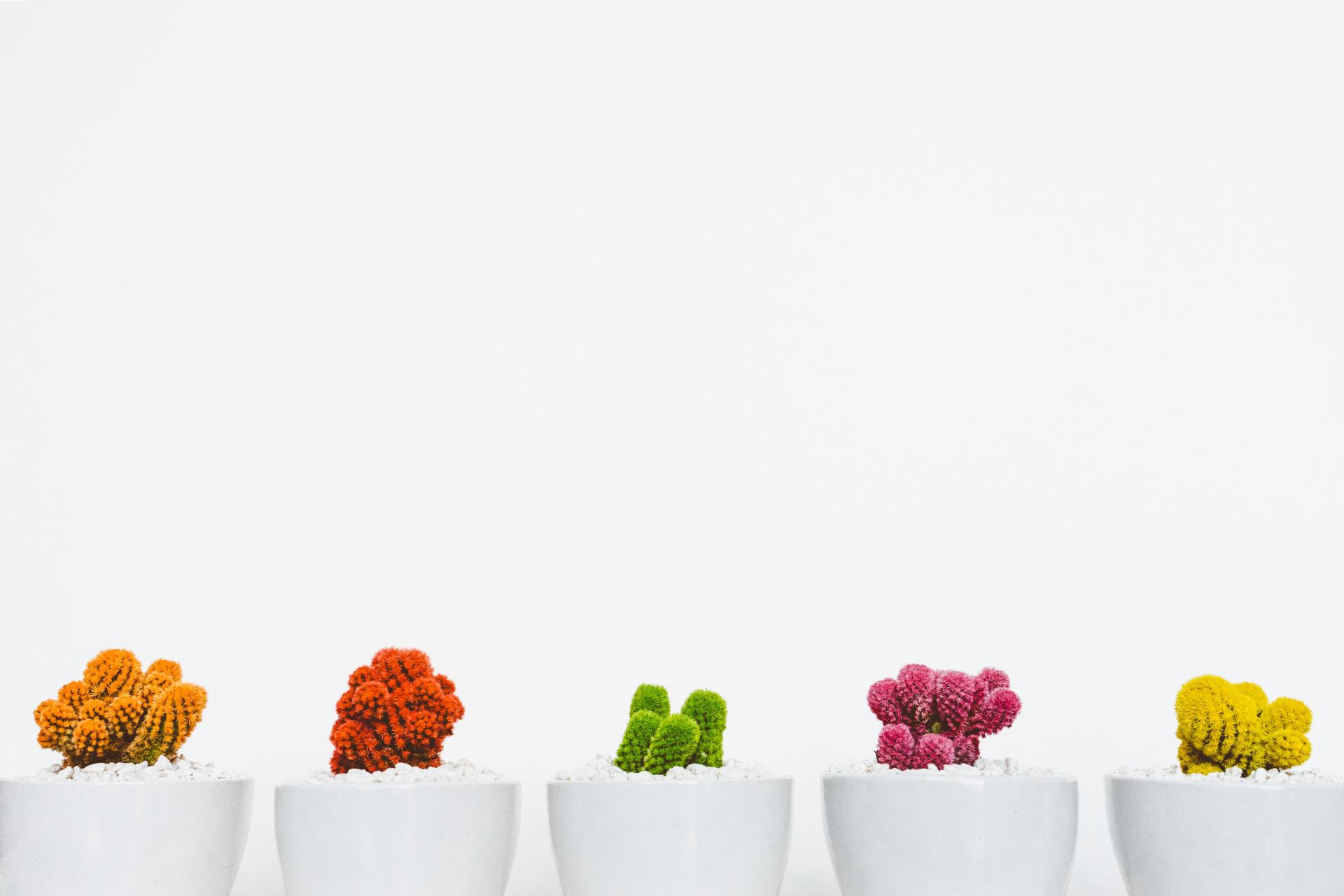
Many plant families have multiple succulents found within them (over 25 plant families).In some families, such as Aizoaceae, Cactaceae, and Crassulaceae, most species are succulents. The habitats of these water preserving plants are often in areas with high temperatures and low rainfall, such as deserts. Succulents have the ability to thrive on limited water sources, such as mist and dew, which makes them equipped to survive in an ecosystem which contains scarce water sources.

In next part, we are going to discuss on how to plant succulent!

In botany, succulent plants, also known as succulents, are plants with parts that are thickened, fleshy and engorged, usually to retain water in arid climates or soil conditions. The word "succulent" comes from the Latin word sucus, meaning juice, or sap.Succulent plants may store water in various structures, such as leaves and stems. Some definitions also include roots, thus geophytes that survive unfavorable periods by dying back to underground storage organs may be regarded as succulents. In horticultural use, the term "succulent" is sometimes used in a way which excludes plants that botanists would regard as succulents, such as cacti. Succulents are often grown as ornamental plants because of their striking and unusual appearance, as well as their ability to thrive with relatively minimal care.

Many plant families have multiple succulents found within them (over 25 plant families).In some families, such as Aizoaceae, Cactaceae, and Crassulaceae, most species are succulents. The habitats of these water preserving plants are often in areas with high temperatures and low rainfall, such as deserts. Succulents have the ability to thrive on limited water sources, such as mist and dew, which makes them equipped to survive in an ecosystem which contains scarce water sources.

In next part, we are going to discuss on how to plant succulent!
0
0
monsterick
2018年10月04日

I finally identified it! its name is Maihuenia Poeppigii... is a very unusual cactus which is mainly native from Chile and small parts of Argentina, it can only be found in the Laguna del Laja national park, so it lives under cold conditions, snow, rains and the south Chilean weather... amazing!
1
0
文章
Miss Chen
2018年09月06日

Hens and chicks plant (Sempervivum tectorum) is named for the rosette, or hen, and small offsets, or chicks, that grow on slender runners extending from the succulent. This sturdy plant thrives in tough growing conditions and needs only a thin layer of soil to develop roots. After the hen flowers and sets seed in summer, it dies back and the chicks fill in the empty spot. Hens and chicks grows outdoors in U.S. Department of Agriculture plant hardiness zones 3 through 8. Sometimes called houseleek, you can also grow hens and chicks as a houseplant.
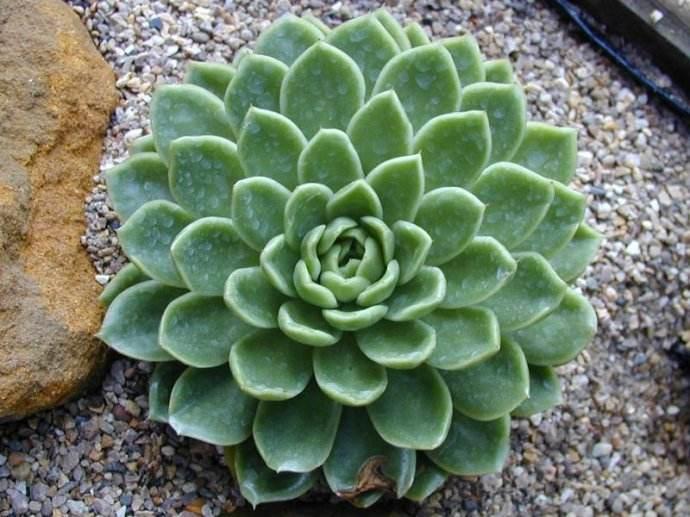
Outdoor Care
Like most succulents, hens and chicks thrive in poor, sandy, well-draining soil and full sun. A spot where the plant gets afternoon shade is best in hot, sunny climates, but too much shade may result in a spindly, pale plant. To plant hens and chicks, loosen the top of the soil with a spade or garden fork, then nestle the plant into the top of the soil. It will soon develop roots that anchor the plant to the soil. Water to a depth of 6 to 8 inches after planting. After that, water only when the soil is dry -- usually every seven to 10 day during hot weather. The plant doesn't need any fertilizer. To keep hens and chicks neat, pinch off flower heads after the plant blooms in midsummer.
Houseplant Hens and Chicks
Hens and chicks performs best and shows its best colors outdoors, but with proper care and a container with drainage holes, you can grow this succulent plant indoors. Plant hens and chicks in a container filled with a mixture of equal parts potting mix and sand, then place the plant in a south-facing window where it gets at least six to eight hours of sun each day. If you don't have a sunny window, place the plant under grow lights or fluorescent bulbs for 14 to 16 hours per day. Allow 6 to 12 inches between the plant and the bulb. Proper watering is critical because succulent plants rot quickly in soggy, waterlogged soil. One watering per week is generally enough during warm weather, but never water the plant unless the soil feels completely dry. Water sparingly during the winter, providing only enough water to keep the plant from shriveling. Let the pot drain thoroughly and never let the plant stand in water.
Making More Hens and Chicks
Hens and chicks is easy to propagate by removing chicks from the hen any time or year. This usually happens because the plant outgrows its garden spot or container or because the hens and chicks are too crowded. Allow the chick to develop until the runner dies back and you can see small roots at the base of the chick. Cut or break the chick from the hen and plant it in a pot filled with a sandy potting soil mix, or in well-drained outdoor spot. To keep from transferring disease to the plant while pruning, wipe the blades of your tools with alcohol and allow to dry before using.
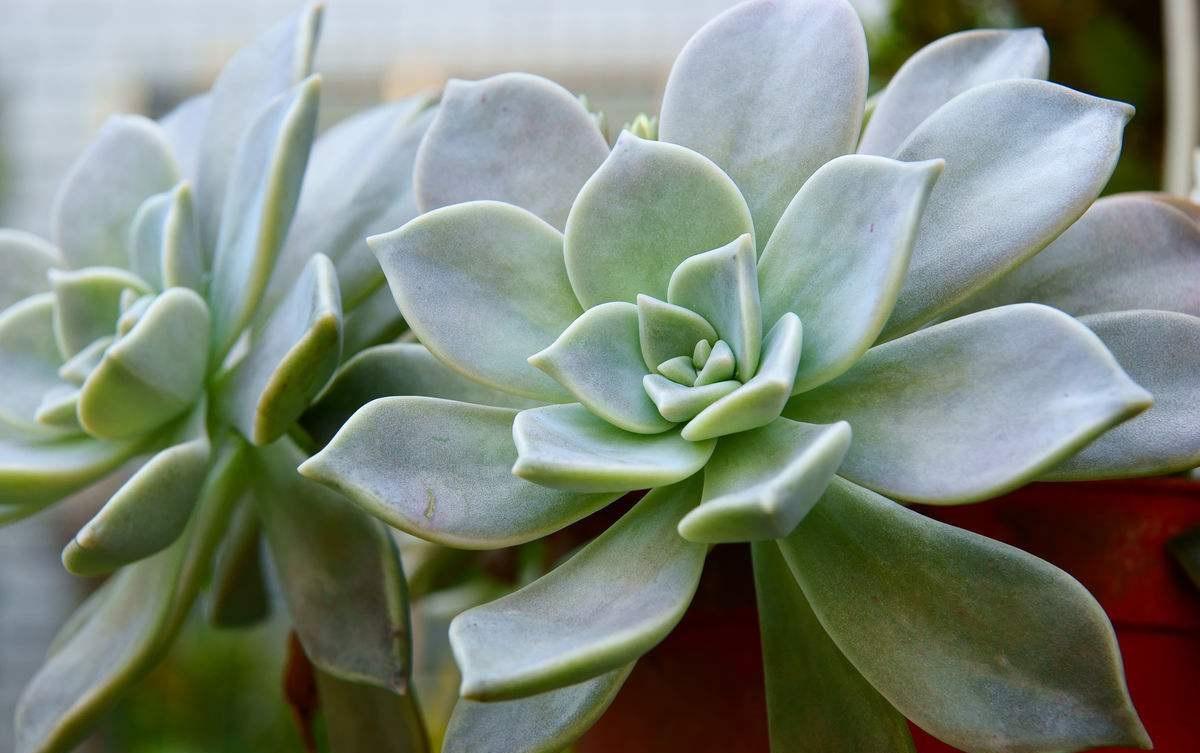
Considerations
Although hens and chicks can spread up to 2 feet wide, they are not considered an invasive plant. Hens and chicks are generally disease-free with the exception of root or stem rot or rust, which occur if hens and chicks are overwatered or placed in soil that doesn't drain well.

Outdoor Care
Like most succulents, hens and chicks thrive in poor, sandy, well-draining soil and full sun. A spot where the plant gets afternoon shade is best in hot, sunny climates, but too much shade may result in a spindly, pale plant. To plant hens and chicks, loosen the top of the soil with a spade or garden fork, then nestle the plant into the top of the soil. It will soon develop roots that anchor the plant to the soil. Water to a depth of 6 to 8 inches after planting. After that, water only when the soil is dry -- usually every seven to 10 day during hot weather. The plant doesn't need any fertilizer. To keep hens and chicks neat, pinch off flower heads after the plant blooms in midsummer.
Houseplant Hens and Chicks
Hens and chicks performs best and shows its best colors outdoors, but with proper care and a container with drainage holes, you can grow this succulent plant indoors. Plant hens and chicks in a container filled with a mixture of equal parts potting mix and sand, then place the plant in a south-facing window where it gets at least six to eight hours of sun each day. If you don't have a sunny window, place the plant under grow lights or fluorescent bulbs for 14 to 16 hours per day. Allow 6 to 12 inches between the plant and the bulb. Proper watering is critical because succulent plants rot quickly in soggy, waterlogged soil. One watering per week is generally enough during warm weather, but never water the plant unless the soil feels completely dry. Water sparingly during the winter, providing only enough water to keep the plant from shriveling. Let the pot drain thoroughly and never let the plant stand in water.
Making More Hens and Chicks
Hens and chicks is easy to propagate by removing chicks from the hen any time or year. This usually happens because the plant outgrows its garden spot or container or because the hens and chicks are too crowded. Allow the chick to develop until the runner dies back and you can see small roots at the base of the chick. Cut or break the chick from the hen and plant it in a pot filled with a sandy potting soil mix, or in well-drained outdoor spot. To keep from transferring disease to the plant while pruning, wipe the blades of your tools with alcohol and allow to dry before using.

Considerations
Although hens and chicks can spread up to 2 feet wide, they are not considered an invasive plant. Hens and chicks are generally disease-free with the exception of root or stem rot or rust, which occur if hens and chicks are overwatered or placed in soil that doesn't drain well.
0
2
文章
Miss Chen
2018年09月05日

Bluebells (Campanula rotundifolia) grow naturally in wooded areas. In the United States they have become a favorite among wildflower lovers. The bluebell is easy to care for and spreads rapidly under the right conditions. This flower is a favorite of hummingbirds because of the shape of its blooms. The flowers are long and narrow, creating the perfect cup for a hummingbird to take nectar from.

Bell-Shaped Flowers
Native to England and Scotland, bluebell is a perennial plant named for the shape of the flower which looks like a tiny bell. These flowers grow in clusters and are usually, but not always, blue as the name implies. Bluebells can be a creamy, off-white color. The cream-colored bluebell is rarely found in nature. This plant has long stems and narrow leaves. It grows to be 12 to 18 inches tall.
Flexiblity for Garden Uses
Because bluebells are native to a range of habitats, including meadows, rocky hillsides, sandy soils and rocky crevices, they work well in many types of gardens. Tuck them into the small openings of a rock wall or among other small plants in a rock garden. Or plant them in a lightly shaded woodland area of your yard where they will multiply and naturalize to form a mass of bright blue in the late spring and throughout the summer. Moreover, bluebells attract hummingbirds wherever you plant them.
Growing Bluebells
Bluebells are common in wooded areas of Scotland, England and the United States, where they grow in USDA zones 3 to 8. They are grown from bulbs, which can endure frosts and hot temperatures. Plant the bulbs 2 inches underground in the fall, before the first frost. Plant bluebells at least 12 inches apart. The bluebell prefers partial sun with some shade in the afternoon. They do well when planted with ferns and other woodland plants. These plants do best when kept moist, so water them daily. Bluebells are useful for keeping the pest nematodes under control.

Propagation for More Plants
Bluebells are rapidly spreading perennials. As perennials, they will return each spring. As they return, they spread in clumps and choke out nearby vegetation if they are not divided every two or three years. Divide plants that are outgrowing their space in the garden. Divide the plants in fall. Place plant divisions in the ground before the threat of frost. Place 2 inches of manure over bulbs in the fall to ensure healthy plants the following spring.

Bell-Shaped Flowers
Native to England and Scotland, bluebell is a perennial plant named for the shape of the flower which looks like a tiny bell. These flowers grow in clusters and are usually, but not always, blue as the name implies. Bluebells can be a creamy, off-white color. The cream-colored bluebell is rarely found in nature. This plant has long stems and narrow leaves. It grows to be 12 to 18 inches tall.
Flexiblity for Garden Uses
Because bluebells are native to a range of habitats, including meadows, rocky hillsides, sandy soils and rocky crevices, they work well in many types of gardens. Tuck them into the small openings of a rock wall or among other small plants in a rock garden. Or plant them in a lightly shaded woodland area of your yard where they will multiply and naturalize to form a mass of bright blue in the late spring and throughout the summer. Moreover, bluebells attract hummingbirds wherever you plant them.
Growing Bluebells
Bluebells are common in wooded areas of Scotland, England and the United States, where they grow in USDA zones 3 to 8. They are grown from bulbs, which can endure frosts and hot temperatures. Plant the bulbs 2 inches underground in the fall, before the first frost. Plant bluebells at least 12 inches apart. The bluebell prefers partial sun with some shade in the afternoon. They do well when planted with ferns and other woodland plants. These plants do best when kept moist, so water them daily. Bluebells are useful for keeping the pest nematodes under control.

Propagation for More Plants
Bluebells are rapidly spreading perennials. As perennials, they will return each spring. As they return, they spread in clumps and choke out nearby vegetation if they are not divided every two or three years. Divide plants that are outgrowing their space in the garden. Divide the plants in fall. Place plant divisions in the ground before the threat of frost. Place 2 inches of manure over bulbs in the fall to ensure healthy plants the following spring.
0
0
文章
Miss Chen
2018年08月26日

Azaleas, a member of the Rhododendron family, are shrubs that feature green, glossy leaves and clumps of colorful flowers--if grown under the right conditions. Once the heavy clay, alkaline Texas soil has been properly prepared to accommodate these picky bushes, the azalea has been planted in the soil properly and the appropriate spot to receive afternoon shade to protect the shrub from the Texas sun has been chosen the shrub rewards with showy flowers that require only a small amount of attention to maintain in Texas.

Step 1
Choose a location where the plant receives afternoon shade, such as the east or north side of your home, to protect the shrub from the Texas sun. Encore azaleas, which bloom in the spring and then again--for an encore--in the fall, are more tolerant of alkaline soils and heat, making them a good choice for Texas.
Step 2
Place ground pine bark, peat moss and sandy loam on top of the chosen planting spot. Mix with the shovel and build a mound about 12 to 18 inches high and about 4 feet in diameter. The shallow roots of the azaleas grow in this well-aerated, nutrient-rich mixture rather than the heavy clay soil of Texas.
Step 3
Spread expanded shale on top of mound until shale is 2 inches deep.
Step 4
Sprinkle five handfuls of fertilizer on the mound. Mix the planting medium with the shovel, maintaining the mound.

Step 5
Place the shrub in the bucket of water and ensure the root ball is completely submerged. Soak until no bubbles rise to the top of the water. Remove shrub and cut the roots vertically in three places using the knife, allowing for new root growth.
Step 6
Push dirt to the side in the middle of the mound. Make a hole almost the depth of the root ball. Place the azalea in the hole, ensuring the top of the root ball is slightly above ground.
Step 7
Push the dirt back around the outside of the root ball, leaving the crown exposed. Mulch the entire mound without covering the crown or allowing the mulch around the trunk of the azalea. Mulch about 3 inches deep. Water well.
Step 8
Check soil around the new shrub every day to ensure soil is slightly damp. Water when soil is dry. When growth of new leaves and flowers is obvious, water the root area well once or twice per week, depending on the weather. Maintain mulch depth for retention of moisture. Azaleas have shallow root systems and dry out quickly in the Texas heat.
Step 9
Prune leggy stems just after flowering to make the shrub dense and compact. Do not prune or fertilize after budding begins around late July. Fertilize after pruning.

Step 1
Choose a location where the plant receives afternoon shade, such as the east or north side of your home, to protect the shrub from the Texas sun. Encore azaleas, which bloom in the spring and then again--for an encore--in the fall, are more tolerant of alkaline soils and heat, making them a good choice for Texas.
Step 2
Place ground pine bark, peat moss and sandy loam on top of the chosen planting spot. Mix with the shovel and build a mound about 12 to 18 inches high and about 4 feet in diameter. The shallow roots of the azaleas grow in this well-aerated, nutrient-rich mixture rather than the heavy clay soil of Texas.
Step 3
Spread expanded shale on top of mound until shale is 2 inches deep.
Step 4
Sprinkle five handfuls of fertilizer on the mound. Mix the planting medium with the shovel, maintaining the mound.

Step 5
Place the shrub in the bucket of water and ensure the root ball is completely submerged. Soak until no bubbles rise to the top of the water. Remove shrub and cut the roots vertically in three places using the knife, allowing for new root growth.
Step 6
Push dirt to the side in the middle of the mound. Make a hole almost the depth of the root ball. Place the azalea in the hole, ensuring the top of the root ball is slightly above ground.
Step 7
Push the dirt back around the outside of the root ball, leaving the crown exposed. Mulch the entire mound without covering the crown or allowing the mulch around the trunk of the azalea. Mulch about 3 inches deep. Water well.
Step 8
Check soil around the new shrub every day to ensure soil is slightly damp. Water when soil is dry. When growth of new leaves and flowers is obvious, water the root area well once or twice per week, depending on the weather. Maintain mulch depth for retention of moisture. Azaleas have shallow root systems and dry out quickly in the Texas heat.
Step 9
Prune leggy stems just after flowering to make the shrub dense and compact. Do not prune or fertilize after budding begins around late July. Fertilize after pruning.
0
0




